Today I’m bringing you a slightly different article from Novo-Monde. No travel, no hiking, but a rendezvous with an event that brings life to the valley we now call home every year: the Evolène Carnival!
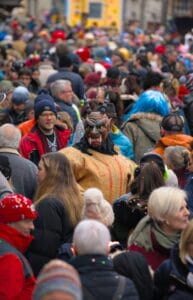
Every winter, the whole valley, and especially the village of Evolène, transforms itself to celebrate a unique carnival. A veritable rendezvous of Alpine traditions, this event combines folklore, scary/imposing costumes and a warm atmosphere that unites locals and visitors alike.
The Evolène Carnival, famous for its peluche, empaillés and colorful characters, is much more than just a festival: it’s a living heritage, handed down from generation to generation, where the past meets the present. Get ready to discover a timeless universe, where the magic of masks and ancient tales will transport you to another world.
Switzerland’s best carnivals
Before delving deeper into our valley’s carnival tradition, I thought I’d start by telling you a little about carnival in Switzerland in a broader sense. Because yes, even if Switzerland isn’t as well known as Brazil and its Rio carnival, we still have many interesting carnival celebrations across the country 😉
In Switzerland, Carnival is a deeply rooted tradition in the Catholic cantons, where it marks the festive period preceding Lent. This festive occasion, which aims to chase away winter and let off steam one last time before Lent, generally takes place in February or early March, with dates varying according to region and local calendar.
Each canton, town and village has its own particularities, but all share the same fervor for this event. Among the country’s most famous carnivals, five in particular stand out:
- Basel Carnival (Basler Fasnacht): Reputed to be the biggest and most spectacular, it kicks off at 4am with the Morgestraich and lights up the city for three days.
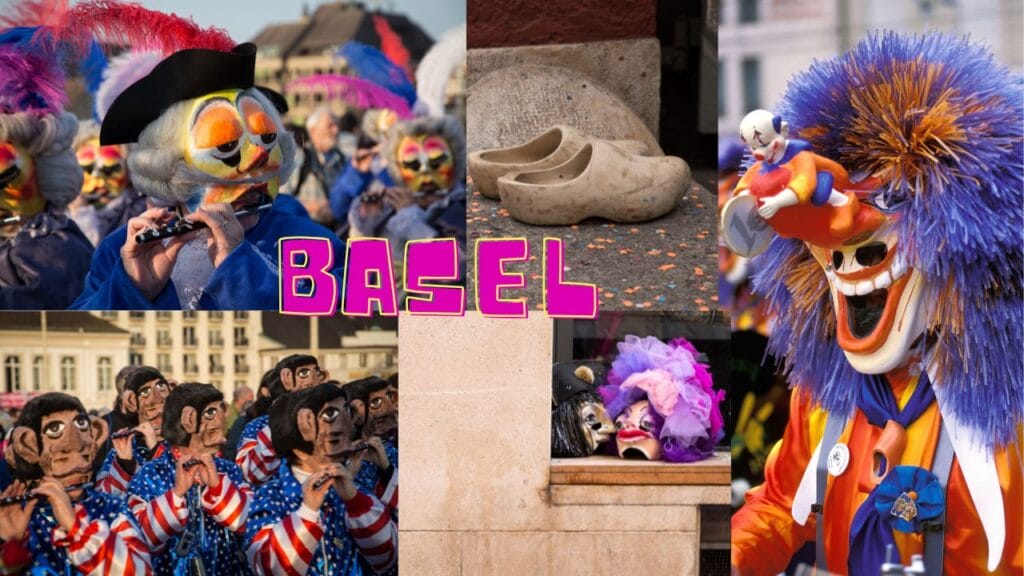
- The Lucerne Carnival (Lozärner Fasnacht): What makes it unique is the wacky atmosphere and “Fritschi” traditions, with exuberant masked characters and “Guggenmusiken” brass bands playing festive tunes in the streets. The festivities begin with a cannon shot at dawn, marking the start of a celebration where creativity and good humor are the order of the day.
- Berne Carnival: It all starts on Thursday with the “Bärebefreiig”, when the bear, imprisoned in the cage tower, is awakened from its hibernation and set free. This tradition marks the start of three days of festivities combining folklore, music and a convivial atmosphere in the heart of the Old Town.
- The Lötschental Carnival: a unique event in the Valais, where Alpine traditions and legendary characters come to life. Here, there are no peluches like in Evolène, but rather “Tschäggättä”, strange furry creatures in wooden masks. In 2024, Evolène’s peluches were paraded alongside them 😉
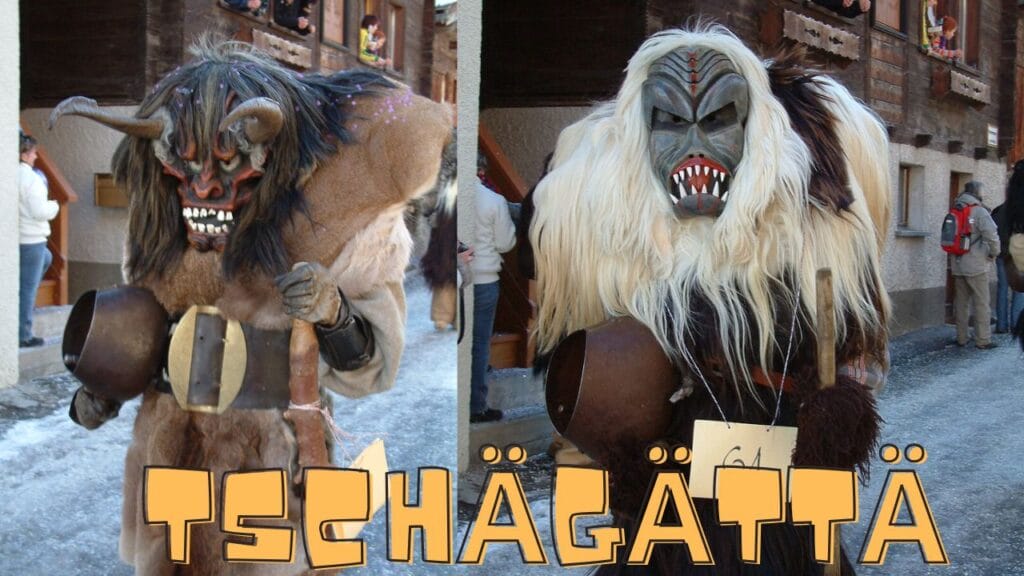
Source : Yan Schweizer, CC BY-SA 3.0, via Wikimedia Commons
- The Bellinzona Carnival (Rabadan): known as Rabadan, is one of the most famous in Ticino and the whole of Italian Switzerland. What makes it unique is the symbolic proclamation of King Rabadan, who takes the keys to the city to launch a week of unbridled festivities.
- The Monthey Carnival: I don’t know if this is one of the best-known, but it’s clearly the one Benoit and I attended the most before moving to the Val d’Hérens. In Monthey, festivities (and alcohol) are more important than traditions, even if the Sunday parade remains a moment that brings young and old together 😉
- Evolène Carnival: I’ve saved the best for last 😉 No, enough chauvinism, this is the one I’m going to tell you about in greater detail here.
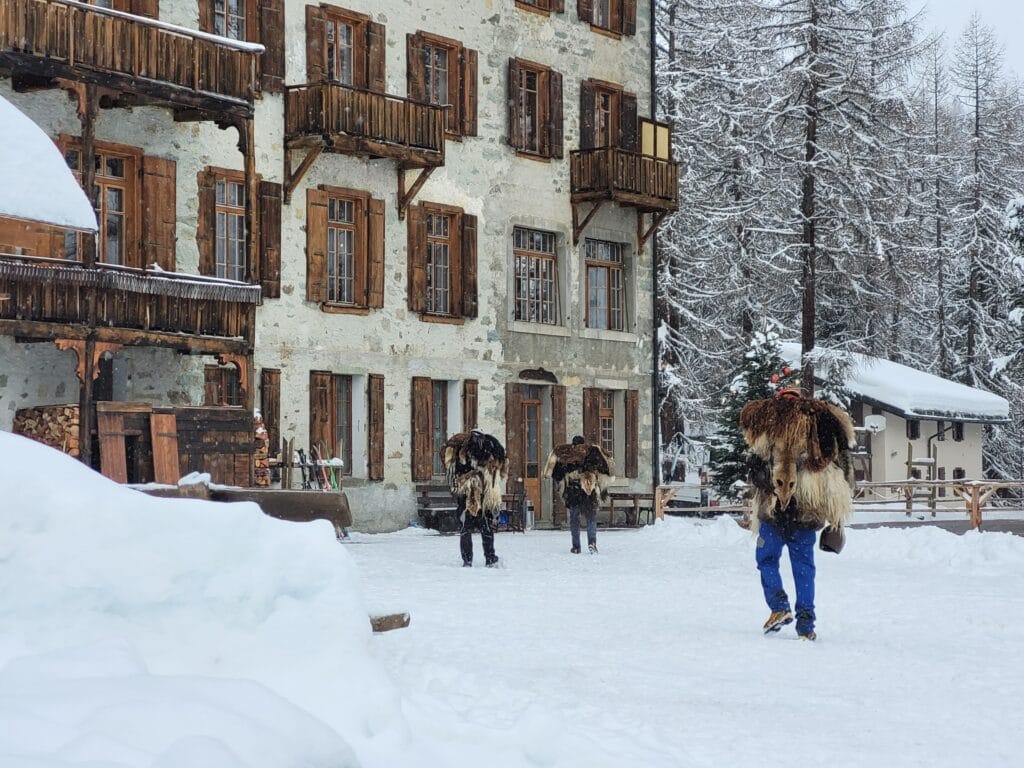
Each carnival, with its rituals and special atmosphere, is a window onto Switzerland’s cultural diversity. Whether you’re a fan of folklore, music or simply curious, carnival in Switzerland is an experience not to be missed.
If you’re planning a trip to Switzerland or if you live here and wish to discover some new spots, don’t miss our new ebook. Released in May 2025, this 75-page guide will help you prepare for your upcoming stay in Switzerland. We’ve compiled all our best tips and tricks for visiting our beloved little country without breaking the bank. You’ll find advice on transportation, accommodations, where to shop, as well as a list of free activities and events throughout the seasons, along with our personal recommendations for hikes and must-see spots, and a selection of off-the-beaten-path itineraries (with estimated budgets). This ultra-complete guide also includes a fantastic interactive map featuring over 500 addresses and deals.

To learn more about the ebook and the interactive map, the introductory article is available here.
Evolene Carnival : the origins
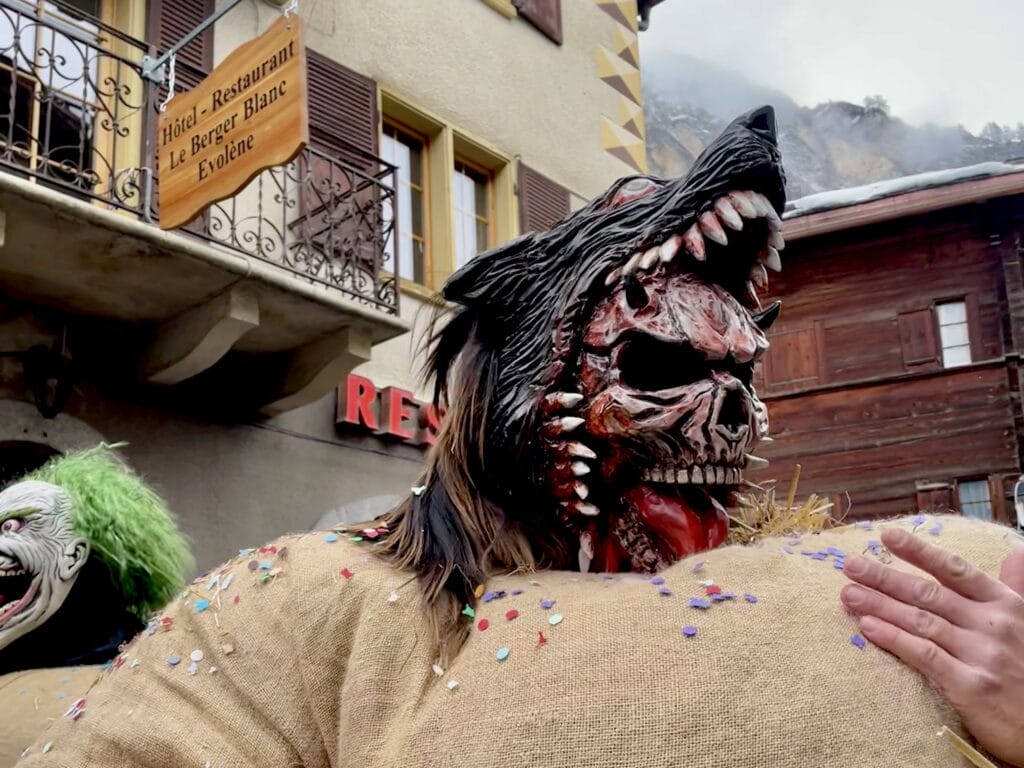
The origins of carnival go back to times long before the arrival of Christianity. These festivities, often associated with masked rituals, marked moments of transition in the cycle of the year, such as the end of winter or the arrival of spring. Whether through Roman Saturnalia, Celtic rituals or Christian adaptations, carnival has always been a space of freedom where social norms could be overturned. Today, these traditions have taken various forms across Europe, but they continue to celebrate folklore.
Carnaval d’Evolène: A Dive into History
Its roots lie in the rituals of the Celtic peoples of the Bronze Age. These communities practiced masked ceremonies to ward off evil spirits and protect their villages from avalanches, hoping to hasten the arrival of spring. The emblematic figures of Carnival, such as peluche and empaillés, probably originated in these ancient customs.
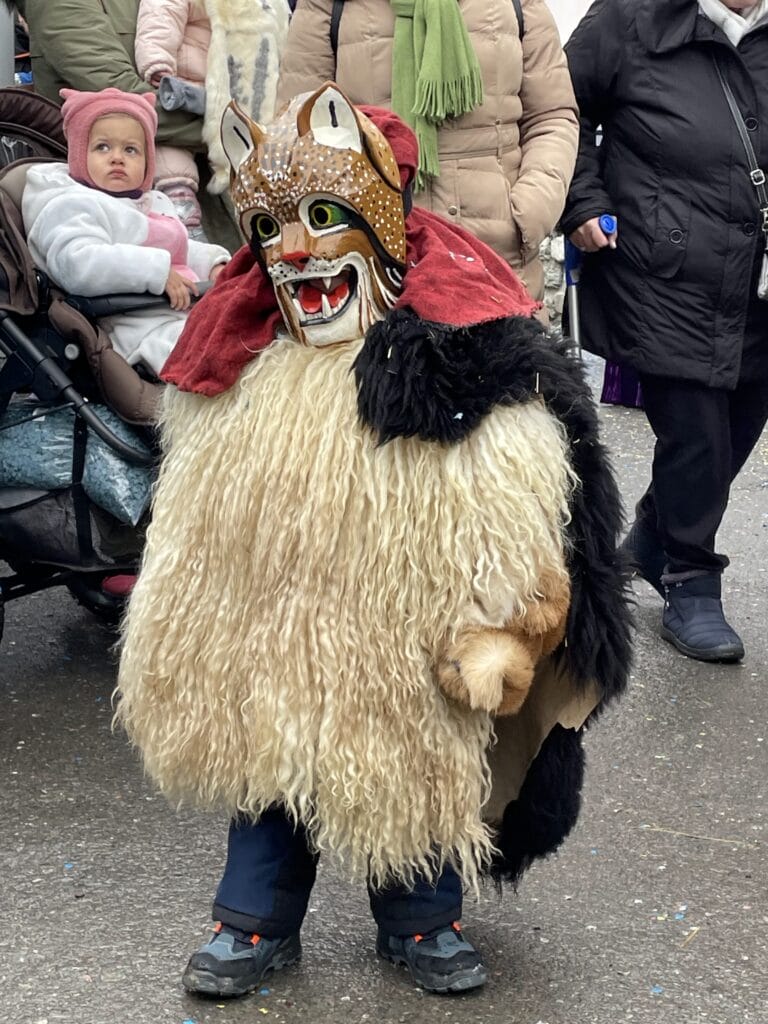
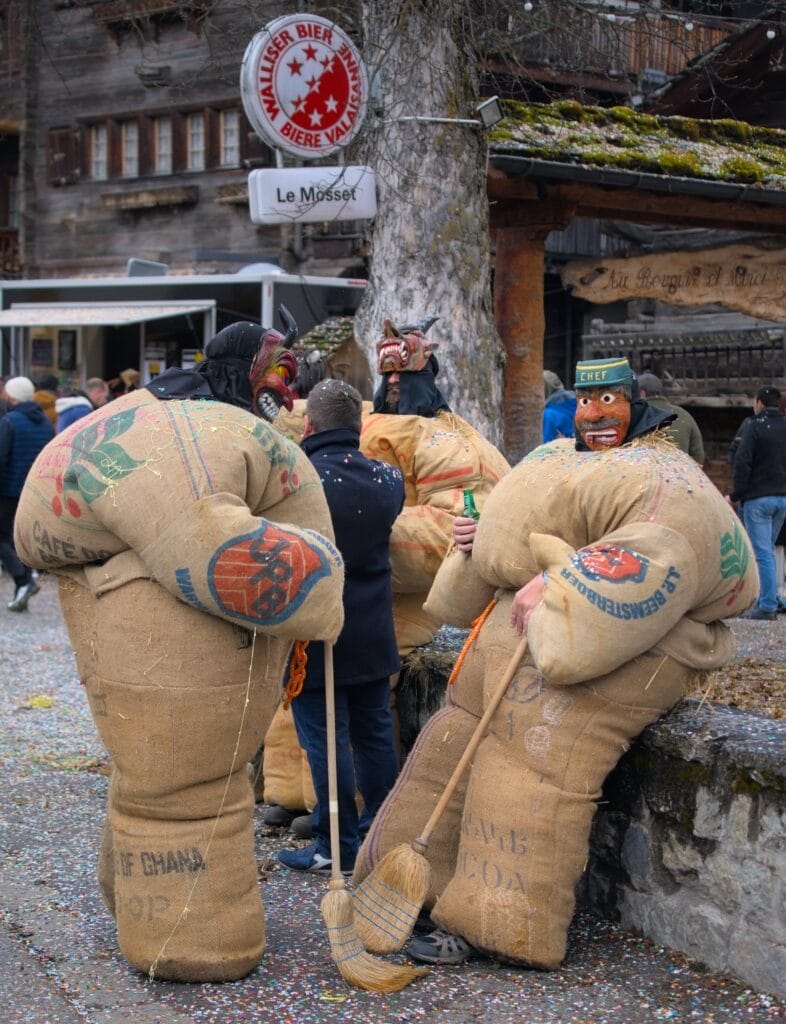
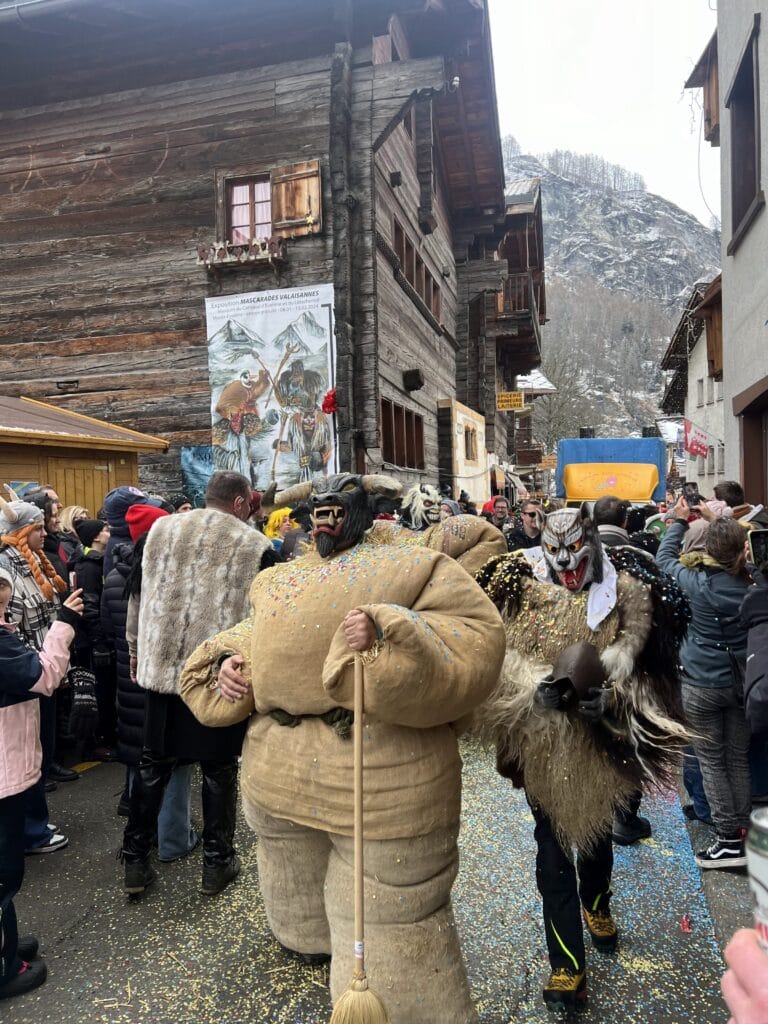
In the IIIᵉ century, the rise of Christianity transformed these festivals. Rather than eliminating them, the Church integrated them into its calendar between Christmas and Easter, giving them a symbolic dimension. Purifying fires, for example, became a means of “burning away sins” before the onset of Lent. In Evolène, this tradition manifests itself in the Poutratze, where fire plays a central role.
A Living, Evolving Tradition
The Evolène carnival is not stuck in the past. It is the fruit of centuries of adaptations, handed down from generation to generation. Even today, it’s mainly the village’s young people (often aged between 10 and 30) who carry on this tradition.
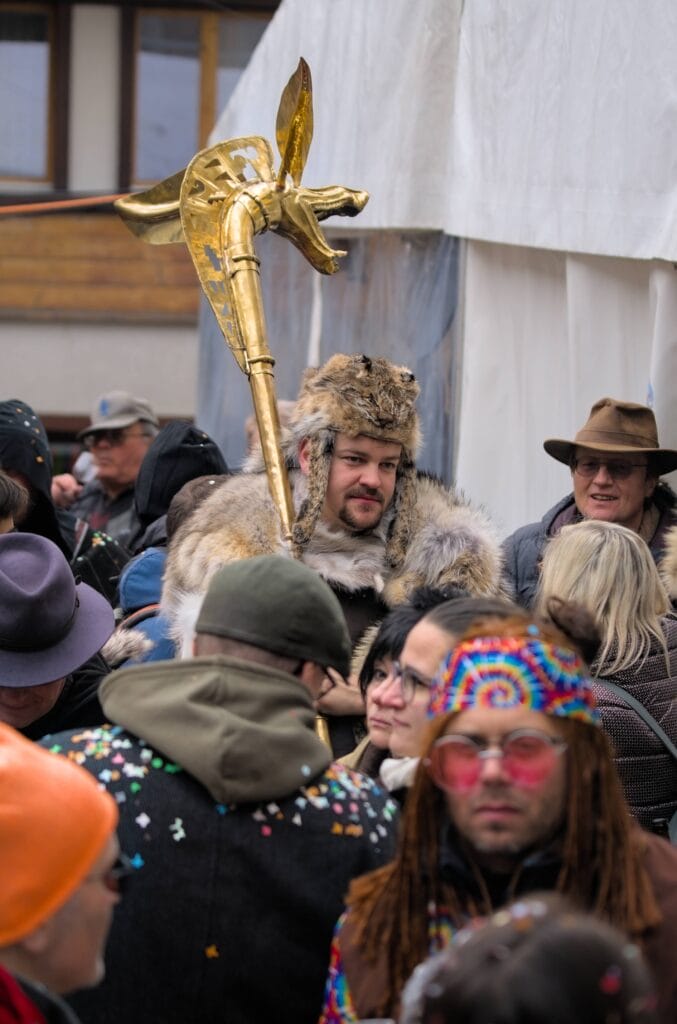
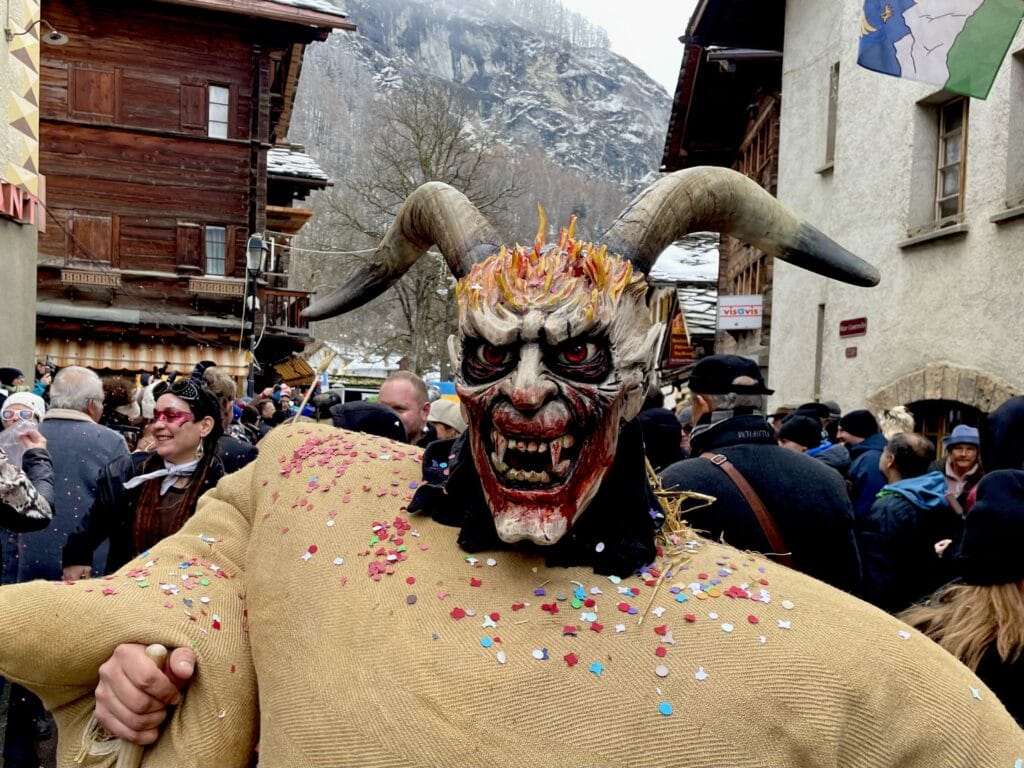
With its spectacular masks, atypical costumes and unique rituals, the Evolène carnival reflects a harmonious blend of Celtic, Roman and Christian influences. This event is much more than just a festival: it’s a living testimony to the history and identity of a village that has been combining tradition and modernity for thousands of years.
Evolène carnival characters
Carnival wouldn’t be the same without the mythical characters that are part of Evolénard traditions. Here’s a quick look at the characters who make our carnival so vibrant every year.
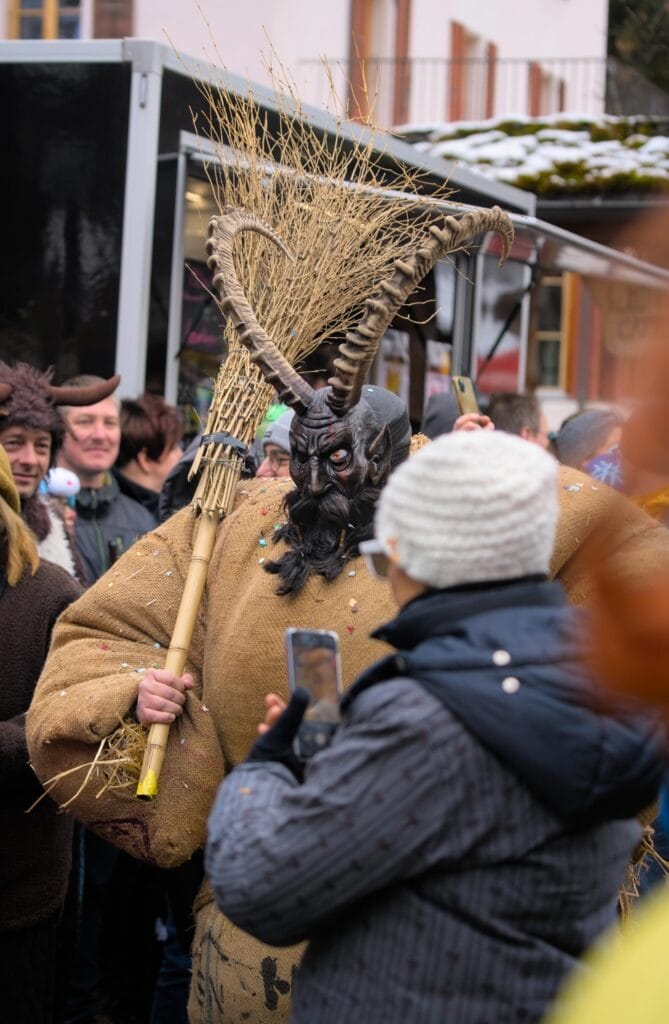
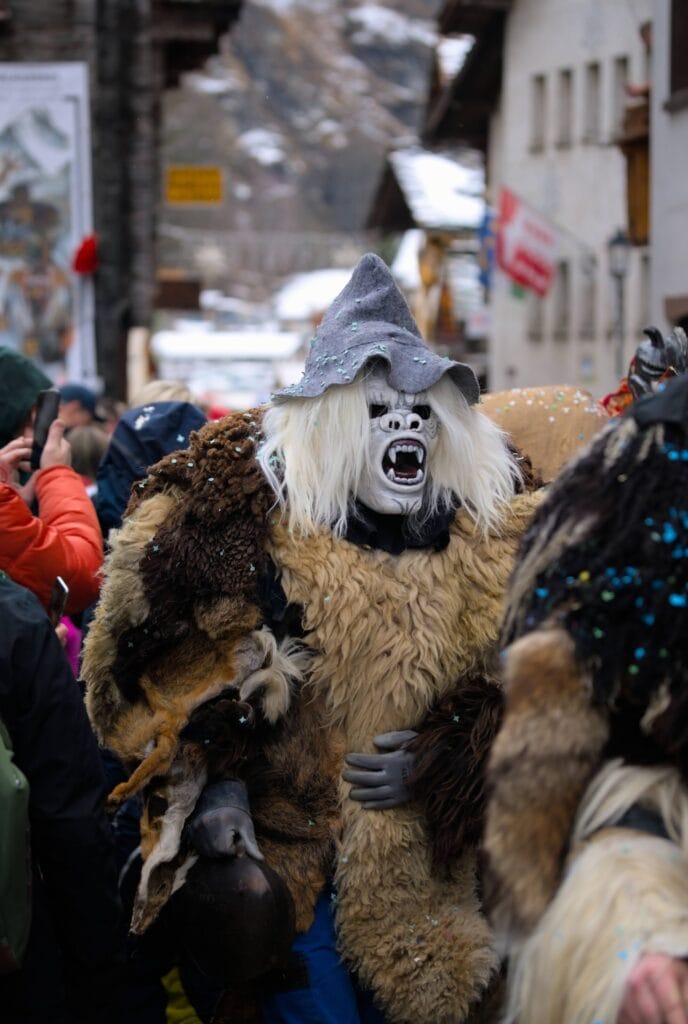
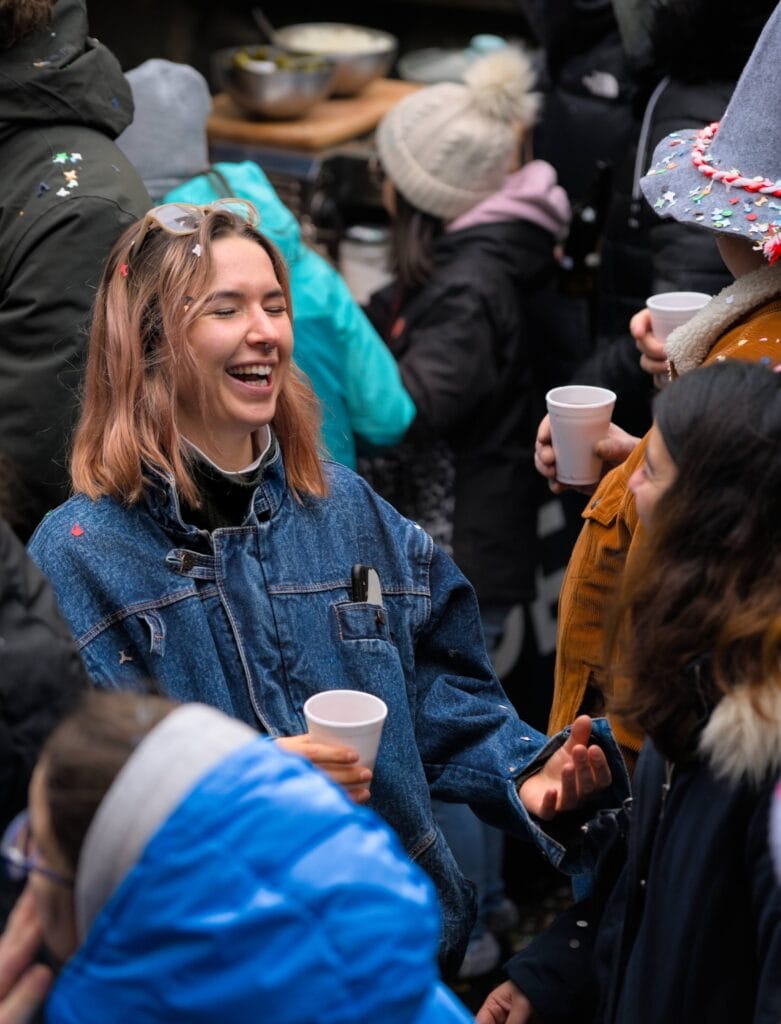
The peluches
Peluche are often seen as the “attraction” of the Evolène carnival. They are the first to “come out” (usually the weekend after Epiphany), and their cowbells echo through the streets of Evolène throughout the entire festivities. It’s hard to say when they’ll be here, as these creatures are notorious for doing as they please and, above all, for ruling the region during carnival! After that, it’s statistically more likely that you’ll come across them after dark, especially at weekends (although you can never be sure of seeing them on the slopes either) 😉
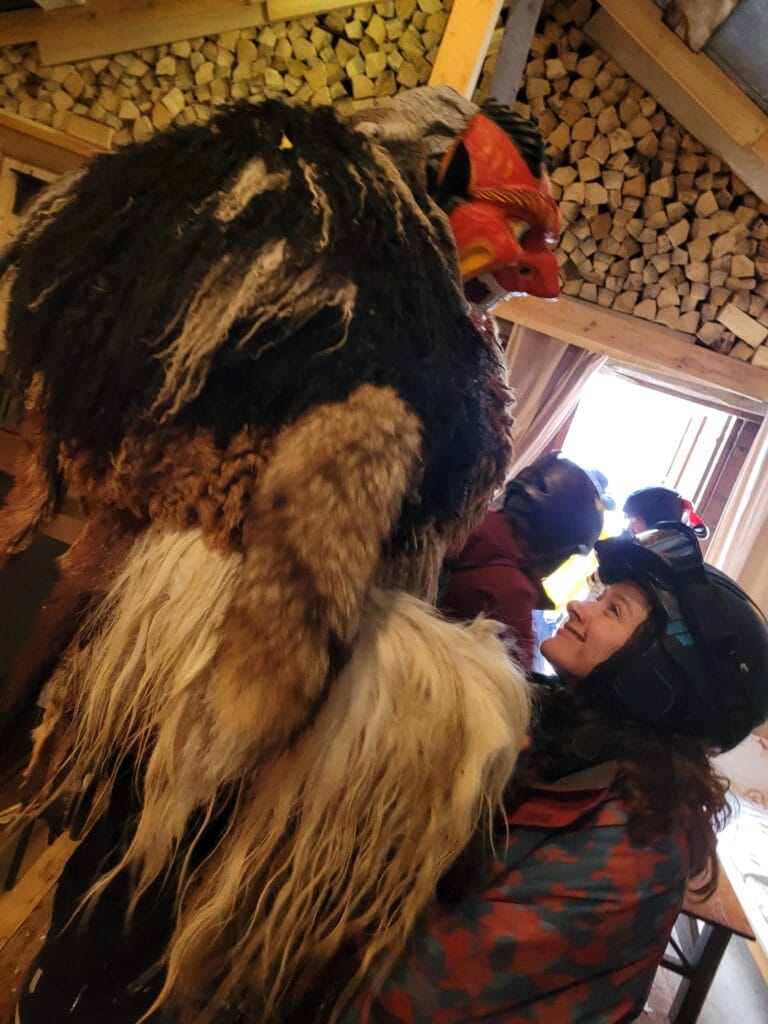
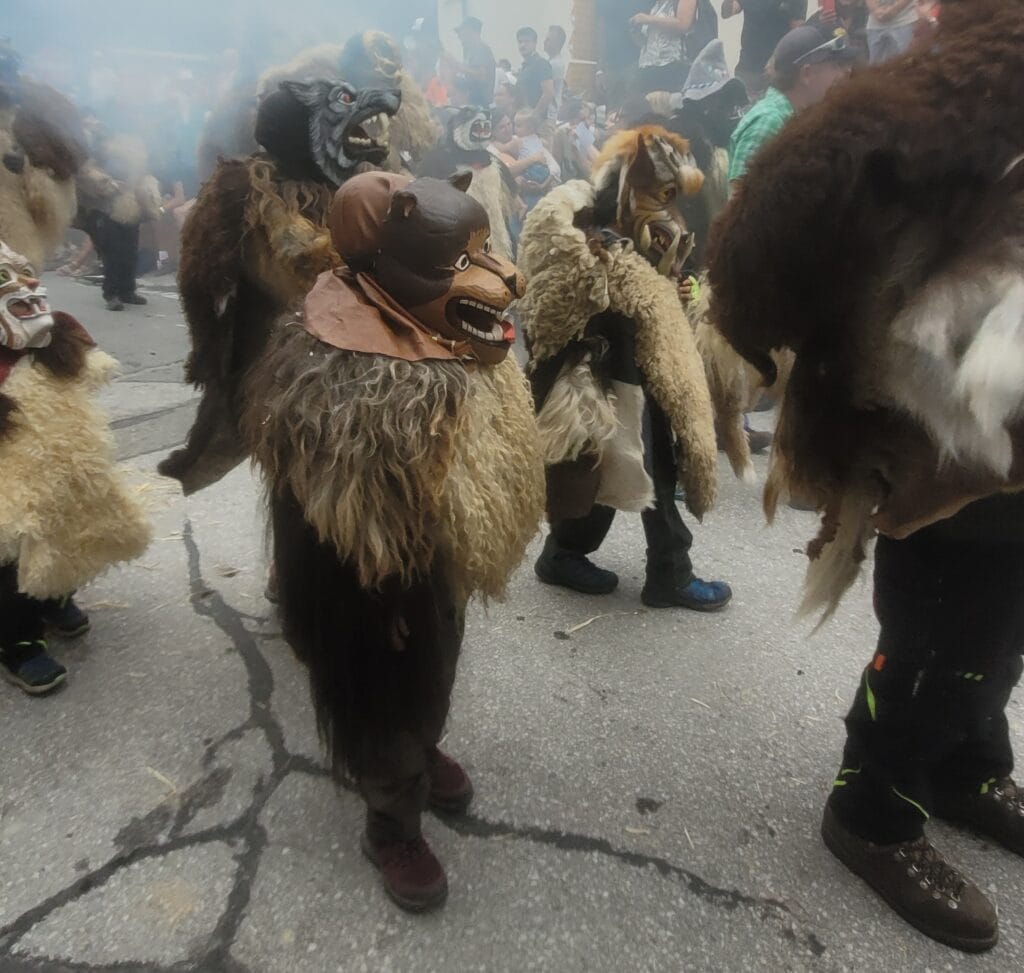
They wear masks hand-carved from arolle wood, called visagères. These handcrafted masks, often handed down from generation to generation, are painted to depict animal heads such as cats, foxes or wolves. Today, these masks are also inspired by exotic animals, imaginary monsters or figures from horror films.
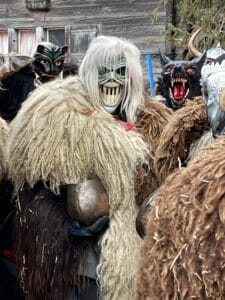
The costume itself is made from untanned sheep, goat, chamois, fox or groundhog skins, and can weigh up to 15 kilos. The important detail in the above sentence is the “untanned”. If it’s relatively easy to hear the peluches arriving thanks to their bell, but it’s also often possible to “smell” their presence, as this costume smells so strong.
With their frightening masks, deafening bells and the raw smell of their skins, the peluches were there to chase away the evil spirits of winter, accused of causing avalanches, cold and disease. They embody the wild force of nature, used to repel these threats.
Today, they’re best known for terrifying children and passers-by! Indeed, watch out if you come across them… They’re very mischievous, and one thing they’re particularly fond of is “rubbing people’s face” . Rubbing the face, you ask? Oh, well, let’s just say that once a peluche gets close to you, chances are she’ll decide to rub your face with her costume (which, let’s not forget, is made of untanned animal skins). I promise you, once you’ve picked up the scent, it’ll stay with you for hours.
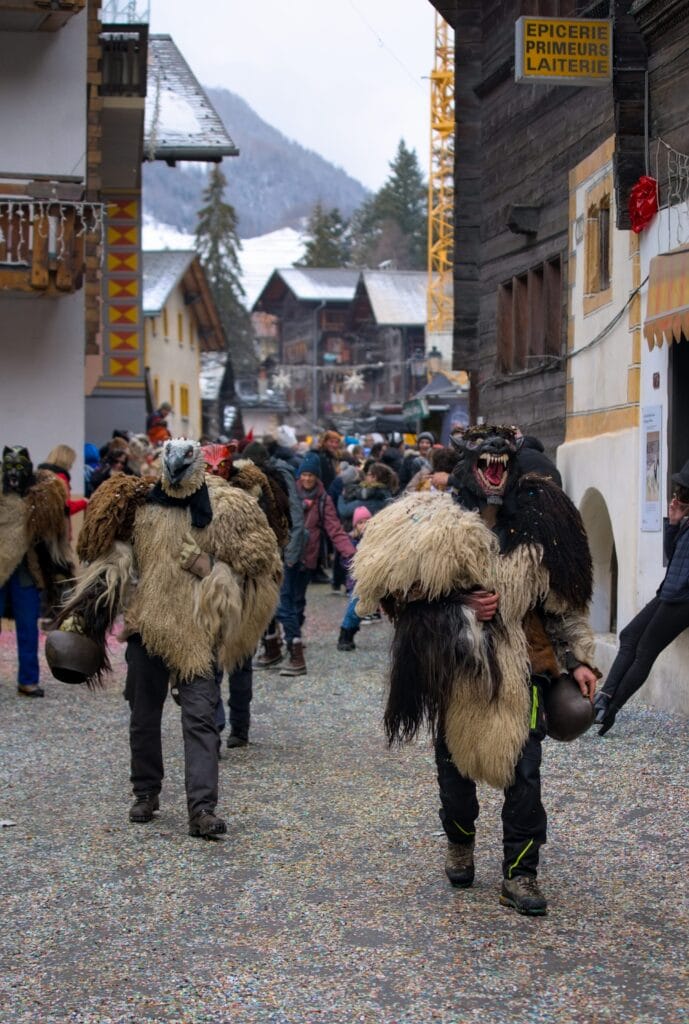
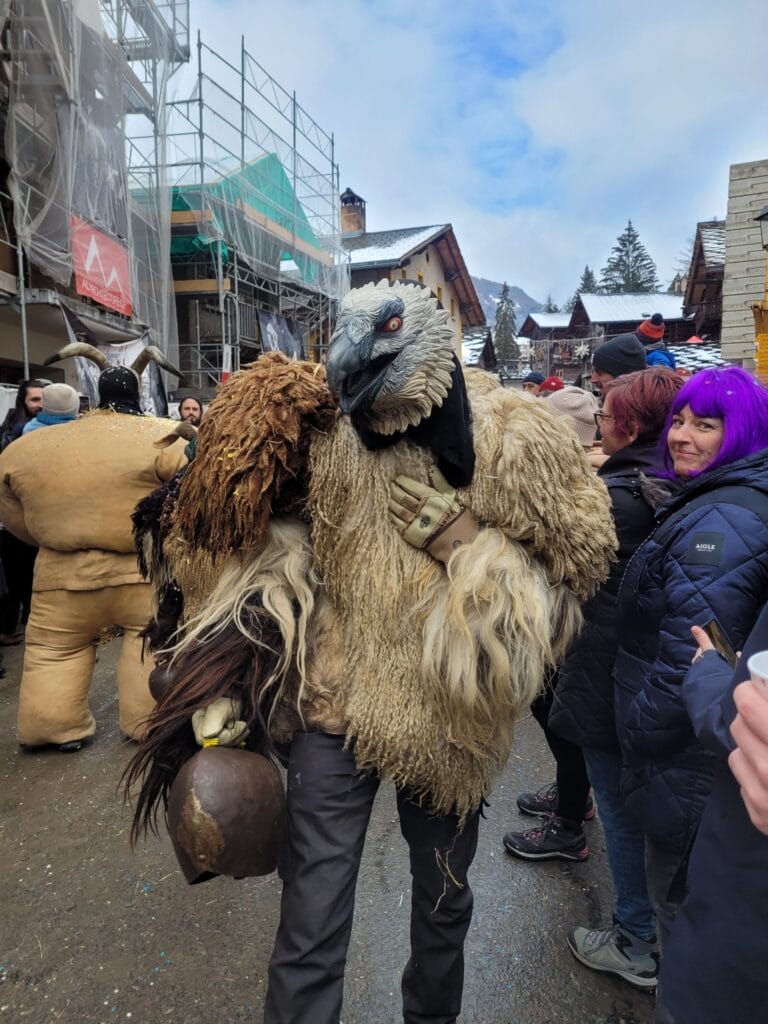
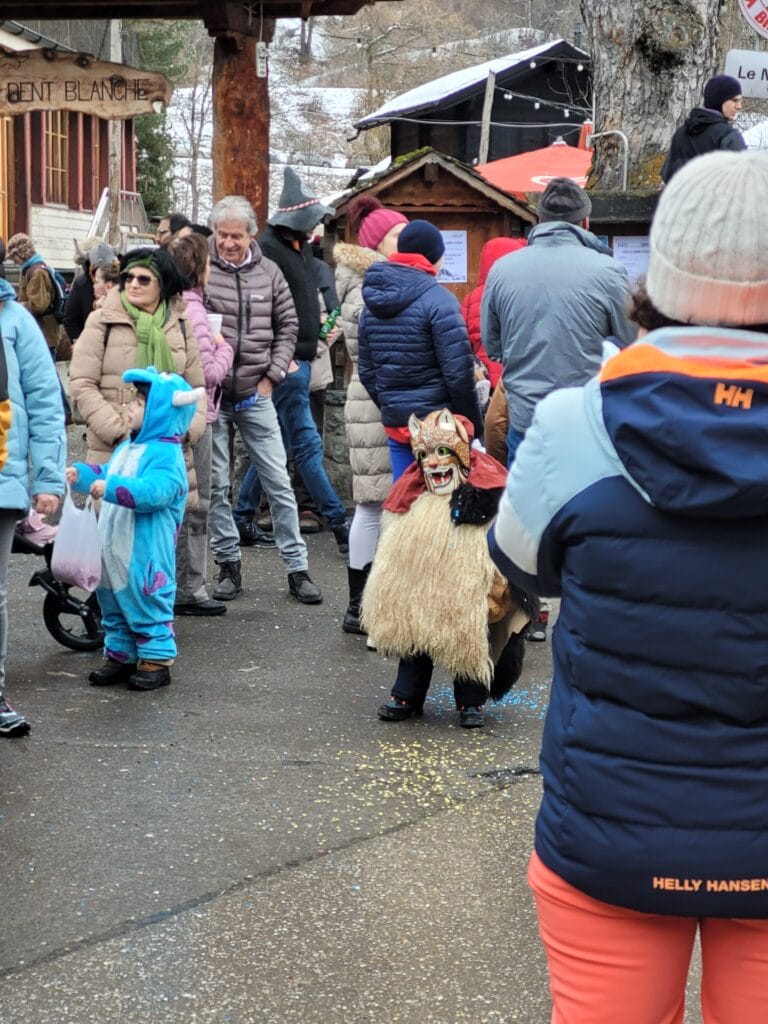
If you don’t want to get your face rubbed, we strongly advise you to move away as soon as you hear the bells ringing!
The Maries
The Maries are a more “recent” tradition at the Evolène carnival. Here, a group of men dress up as Marie, a woman who lived in Les Haudères until the 90s. Very tall and chubby, this woman was known to talk about her intimate problems and give unsolicited advice in patois (the local dialect). Today, the Maries are out and about on the Saturday before Shrove Tuesday. On this occasion, the new “Maries” criss-cross the villages of the commune, calling on passers-by to give them “advice” in patois.
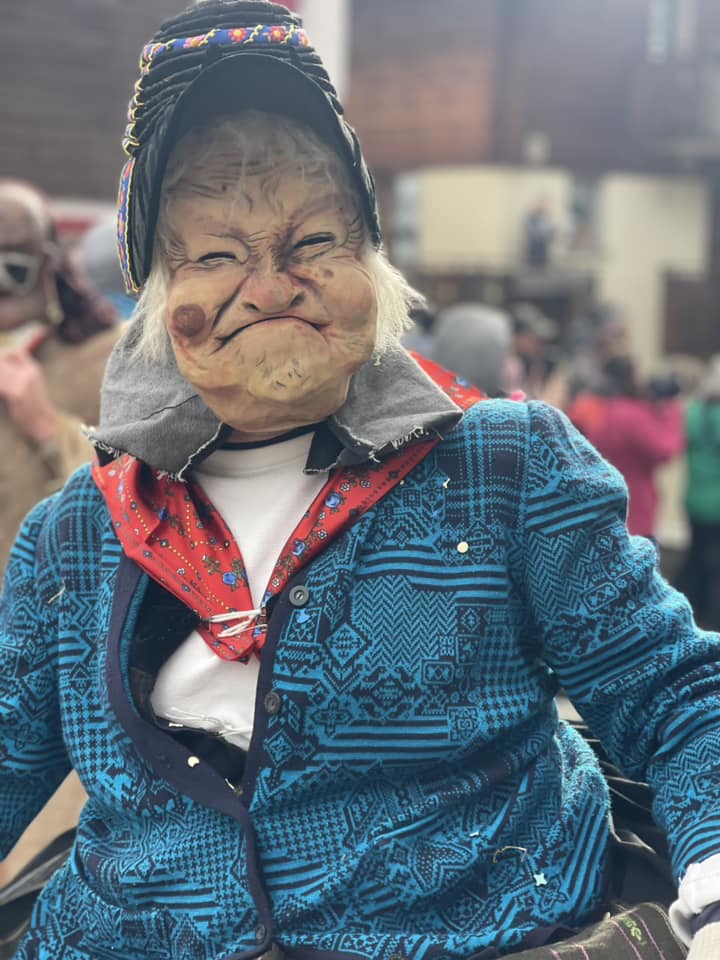
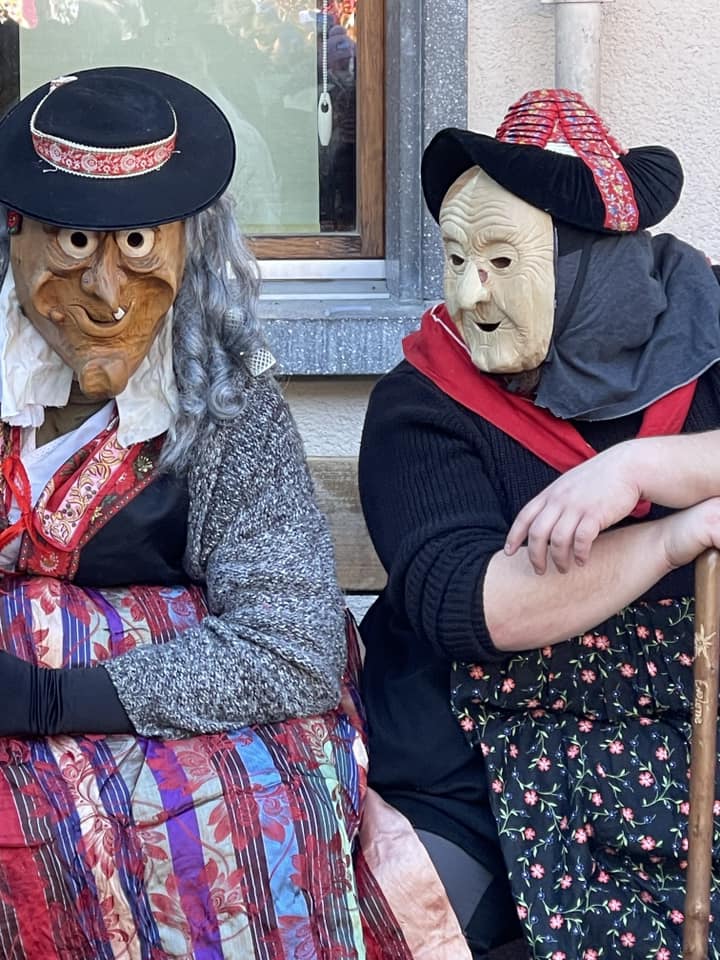
The “Maries” are interpreted by young men who, for a day, dress up in the traditional clothes of the women of the valley. They take care to add plastic tubes under their dress to remind us that dear Marie was quite overweight.
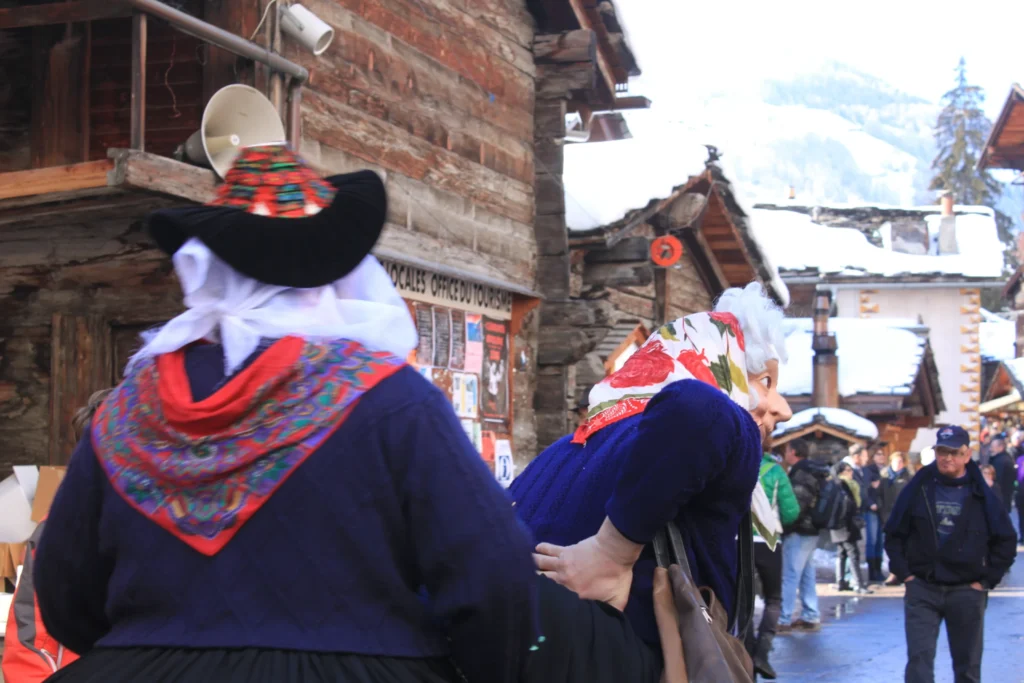
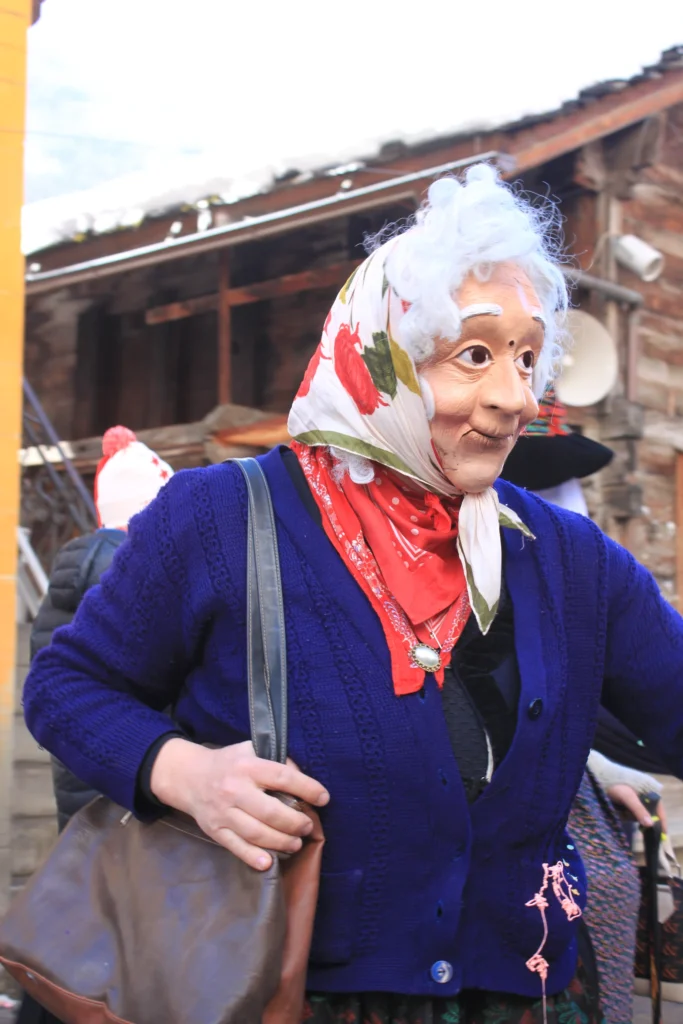
Pictures of the Marie taken by Patricia de YoupiTrip.
The empaillés
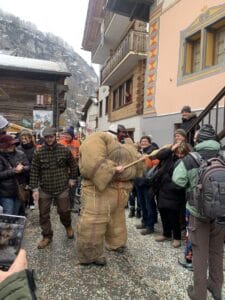
The Evolène carnival owes much of its magic to empaillés, the imposing, emblematic figures that captivate and impress all those who come across them. Unlike peluches, who seek to ward off spirits, empaillés take the opposite approach: they mimic these supernatural presences, the better to befriend them and win their mercy. Armed with a rice broom, expect to be “caressed” by it or sprayed with water (“empaillés” like to dip this famous broom in fountains and then come and spray the crowd).
Carnival Sunday is their day to shine. As soon as mass ends, they parade through the village, becoming the undisputed masters of the place for the rest of the day. Their appearance does not go unnoticed: wrapped in jute sacks filled with around 30 kilos of straw, they intrigue as much as they frighten. Their heavy, unusual gait, combined with their imposing silhouette, reinforces their mysterious aura.
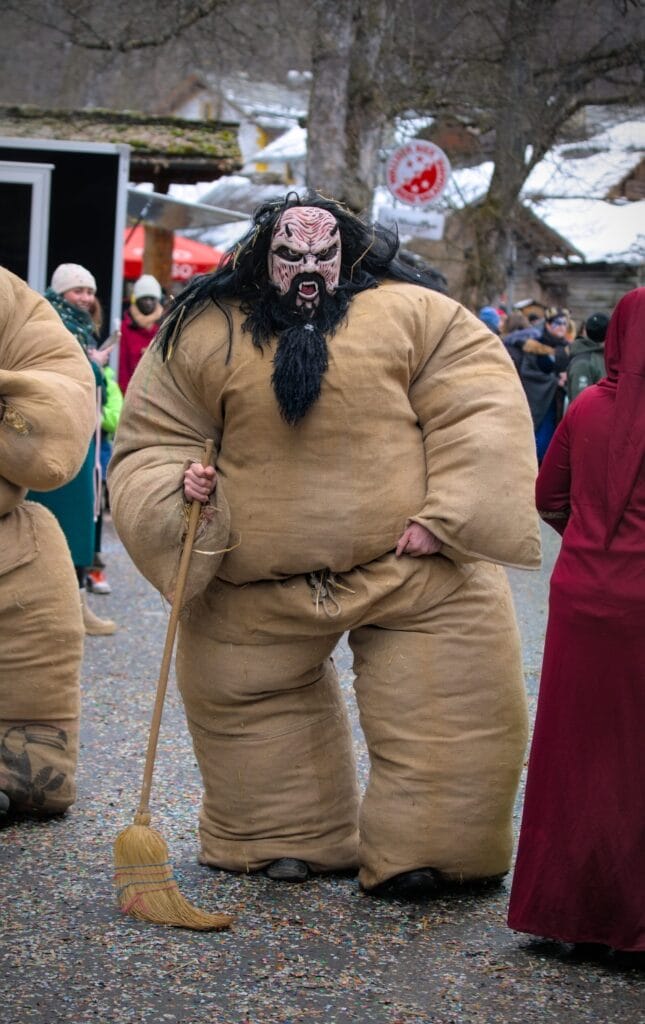
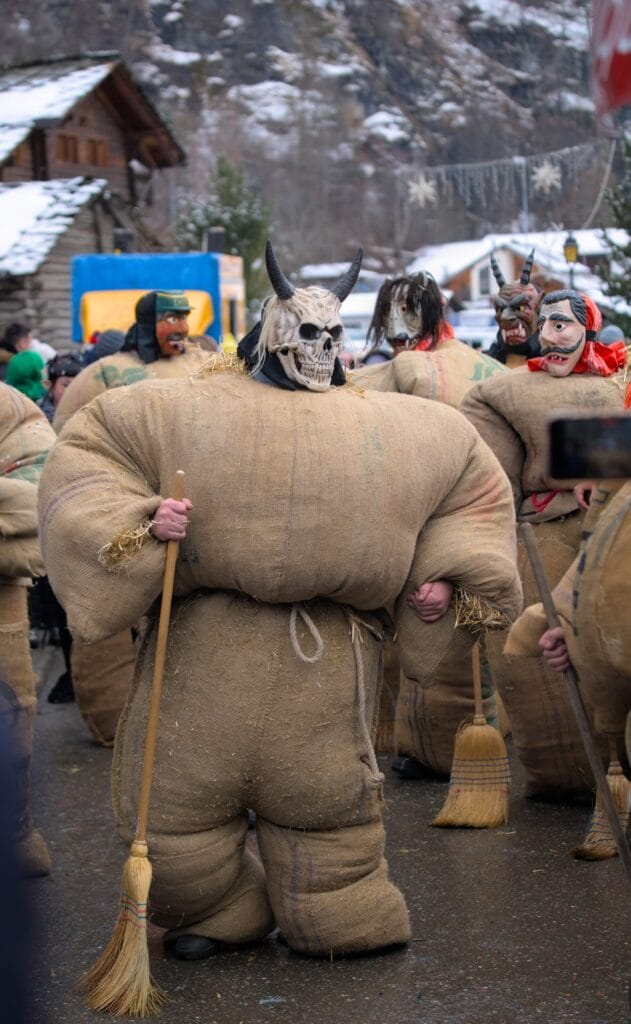
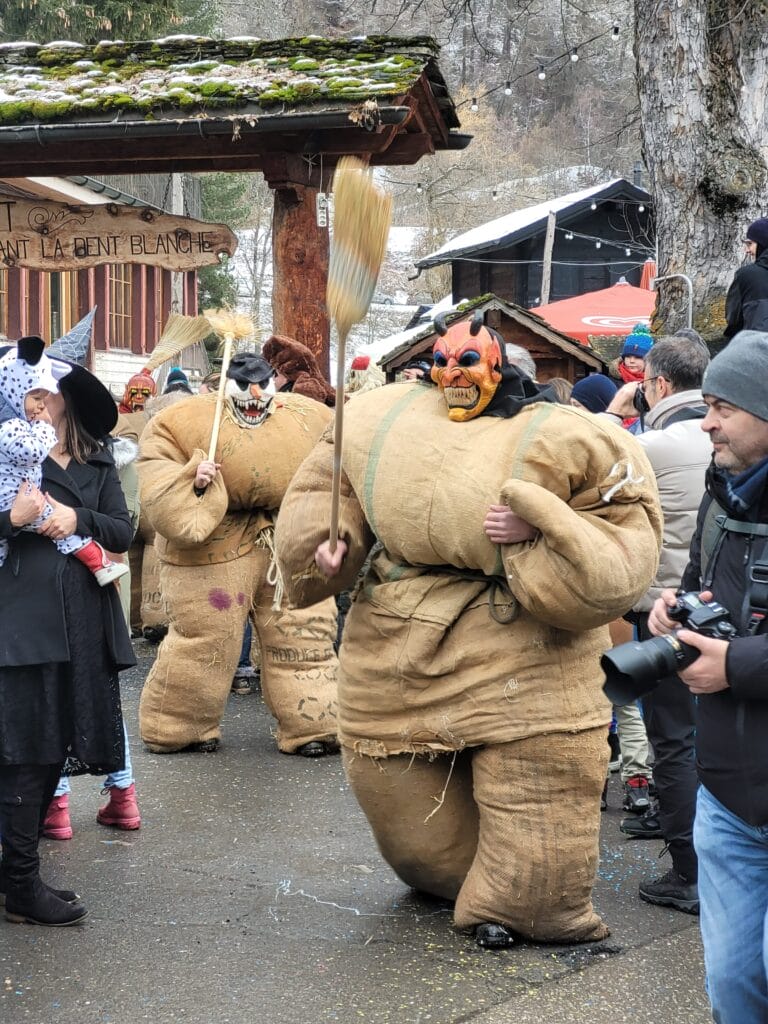
On Sunday mornings (from dawn onwards), you can watch the “stuffing” in the Dent-Blanche park (located behind the pub of the same name). It’s a really great time, and a very impressive one too! Each empaillé is helped by several people to add up to 30kg of straw (and they often have to be helped up once the stuffing is done) 😉
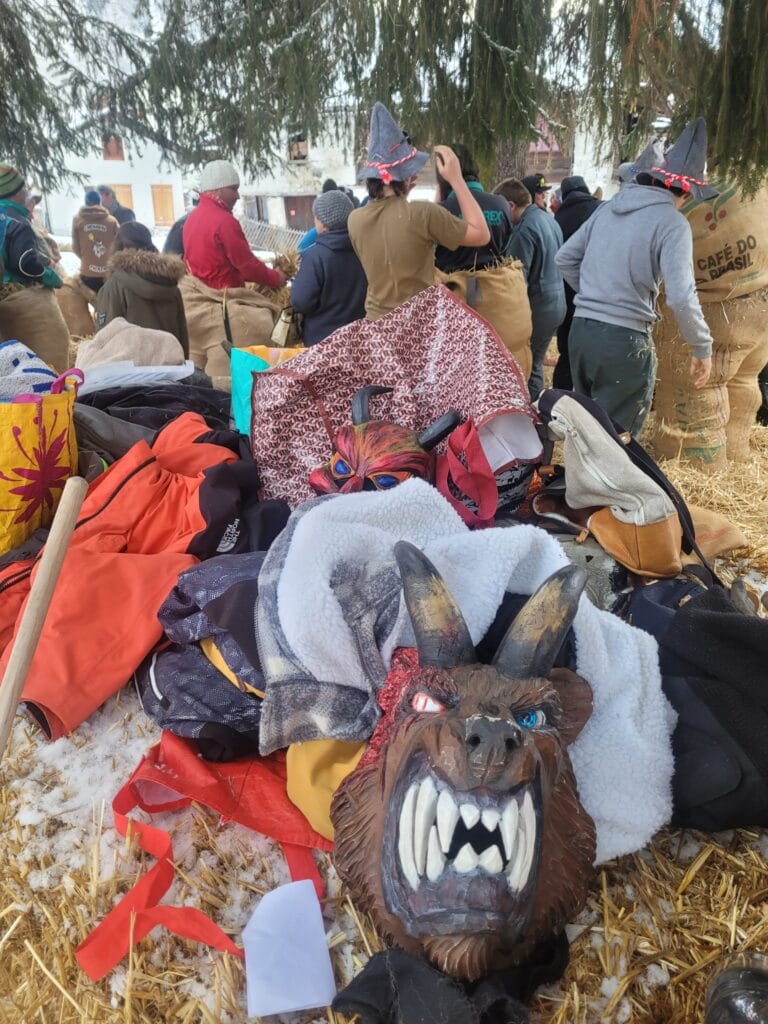
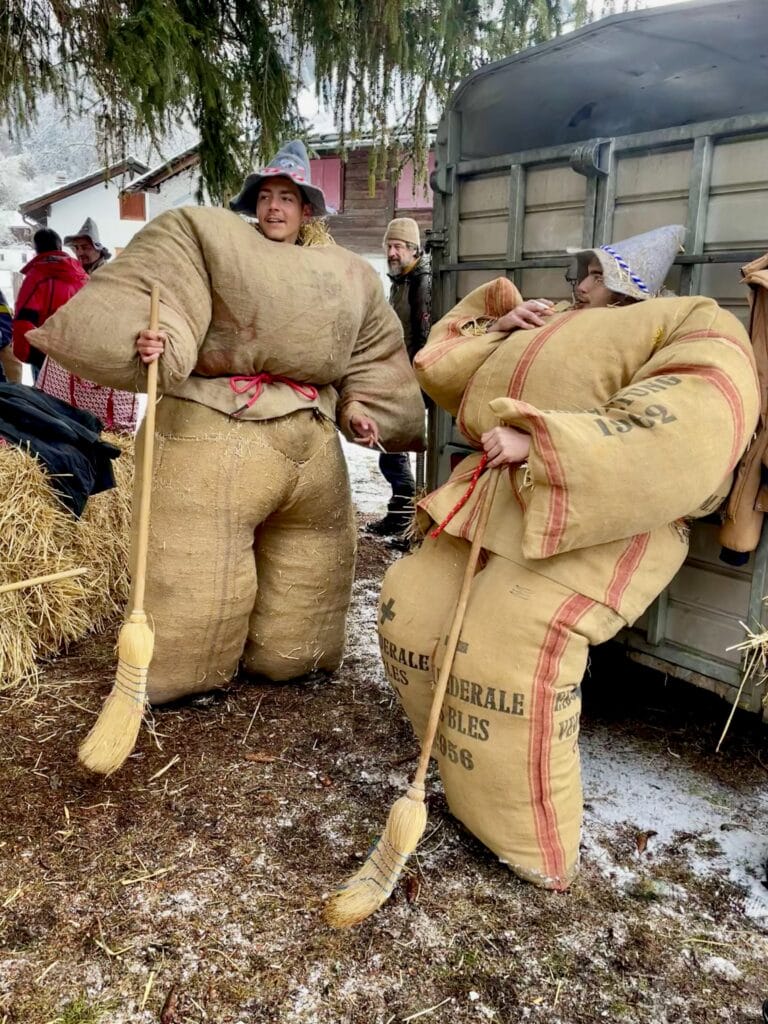
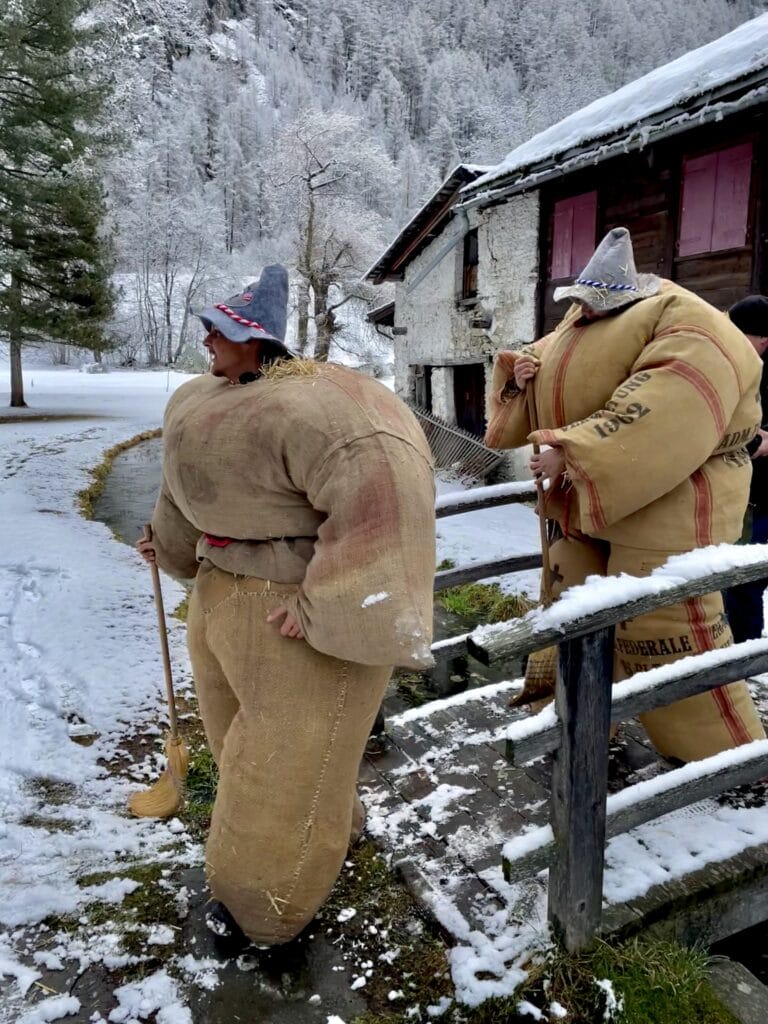
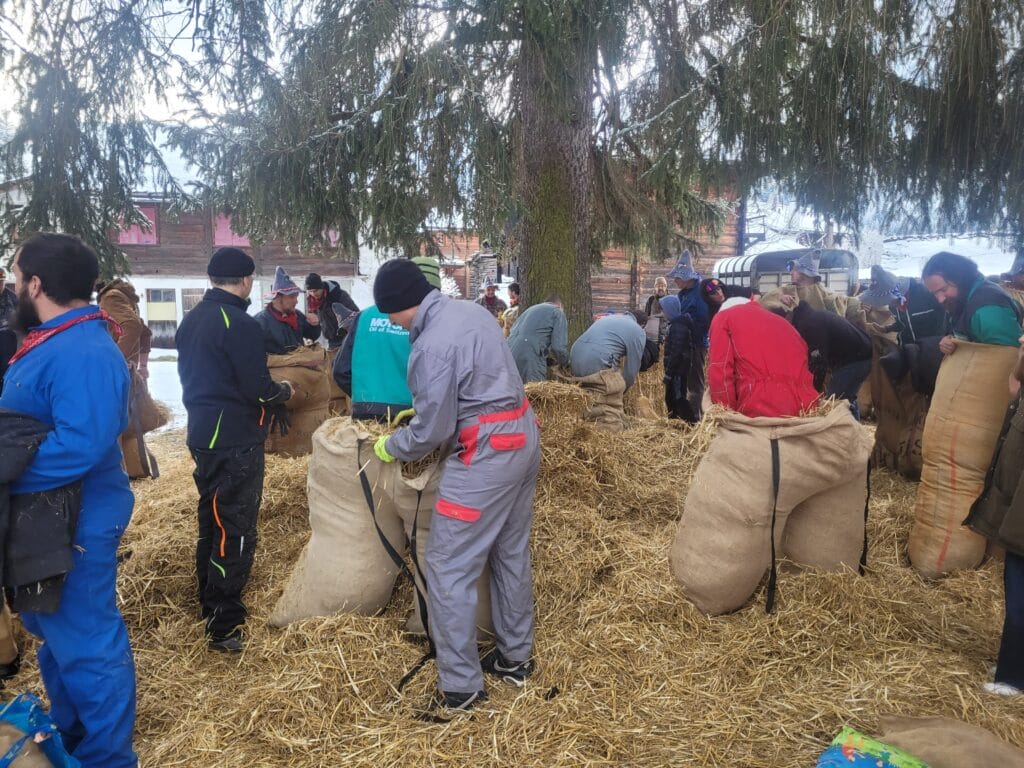
Their masks, hand-carved from arolle wood, are an essential part of their appearance. Unlike peluche masks, which are often inspired by the animal kingdom, empaillés masks are more reminiscent of disturbing human figures, devils or witches from another time.
The “empaillés”, with their disturbing masks, their impressive mass and their symbolic brooms, are the guardians of a tradition. Their role goes beyond that of mere carnival participants: they recall the spirits of ancestors and the souls of the departed who continue to haunt the valley.
The Poutratze
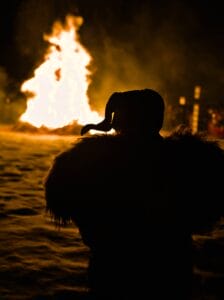
The emblematic figure of the Poutratze, the embodiment of winter in Evolène, is closely linked to the stuffed animals. In fact, it’s an empaillé wearing a different mask that embodies the evil spirits of the winter season.
The Poutratze will be captured, judged and burned on the evening of Mardi Gras, marking the end of the festivities and the long-awaited arrival of renewal.
Personally, I enjoyed the evening immensely! I don’t know, but I found it really moving to see all those people & peluches gathered around the bonfire, watching the flames devour “the Winter Man”. A beautiful end to the festivities that leaves us with that sweet feeling of “can’t wait for next year!”
Carnival is a festive and convivial event, but it’s important to understand that it’s first and foremost a valley tradition, not a tourist attraction. The peluches are “masters” during this period and do things according to their rules. No need to insist on a selfie 😉 Sometimes they’re playful and good-natured, and that may be possible, and sometimes they’re more teasing, and then it’s impossible to approach them without getting “your face rubbed”.
Note also that the bell (cowbell) and the visagère (wooden mask) have a very special meaning for Evolénards. Don’t try to touch them, or you’ll incur the wrath of both the peluches and the locals.
For more information, the carnival association has published a well-done summary on its website, which explains a little better the few basic rules to be respected to celebrate the event in good conditions. (it’s in French but you can use a browser translator to get the idea)
PS : Dressing up is a great way to avoid “getting your face rubbed”. In our experience, the more you play the carnival game, the more docile your peluches become (and also if helps if you offer them something to drink) 😉
Evolène Carnival program
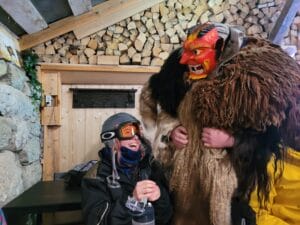
Every year, the Evolène carnival offers new themed events and evenings, and for the official program, there’s nothing better than checking out the association’s website! After that, remember, the peluches are the masters of this party and they do as they please. You’re more likely to come across them after dark and on weekends (before Shrove Thursday, I mean), but who are we to tell them when to come out and when not? Maybe you won’t run into them on a Saturday night, but on a Monday morning at the bakery 😉
After that, although the precise program evolves and adapts over the years, there are still a few key dates and events to remember for the Evolène carnival.
January 6: Epiphany Day also marks the awakening of Carnival! In the evening, young people go round the villages of the commune with cowbells.
From Epiphany to “Jeudi Gras” (Shrove Thursday): a whole host of themed evenings are organized in the various villages, and sometimes even on the ski slopes. You’re never completely safe from a peluche who wants to give you a “gentle cuddle”… But don’t panic: you can always hear them coming thanks to their bells!
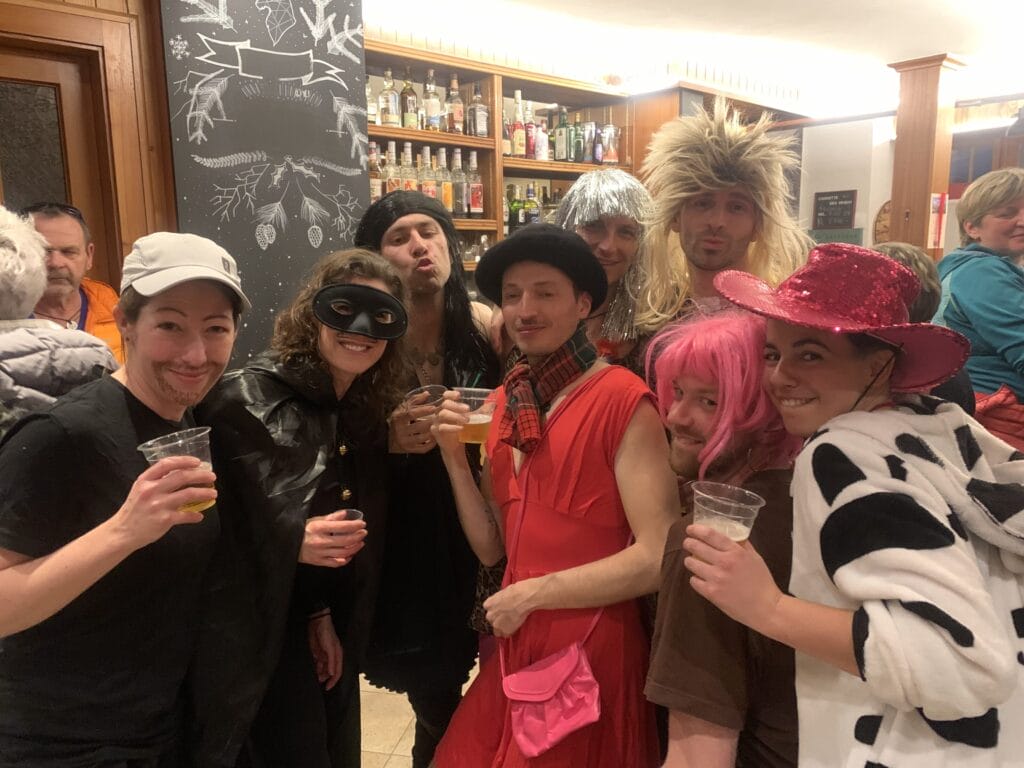

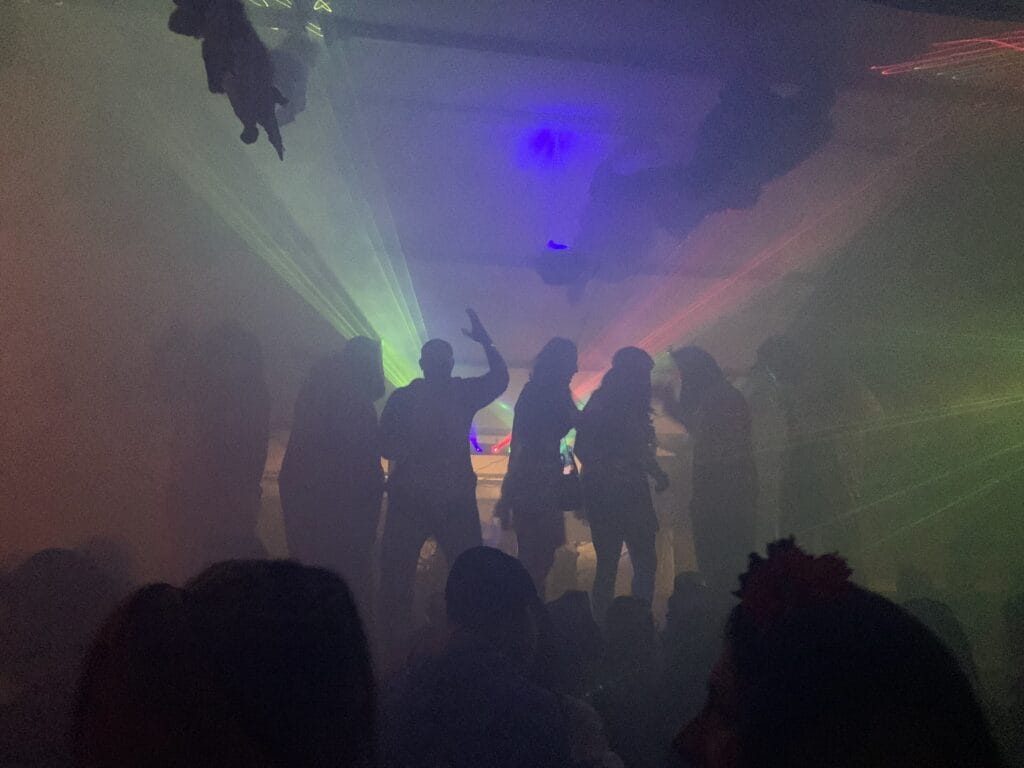
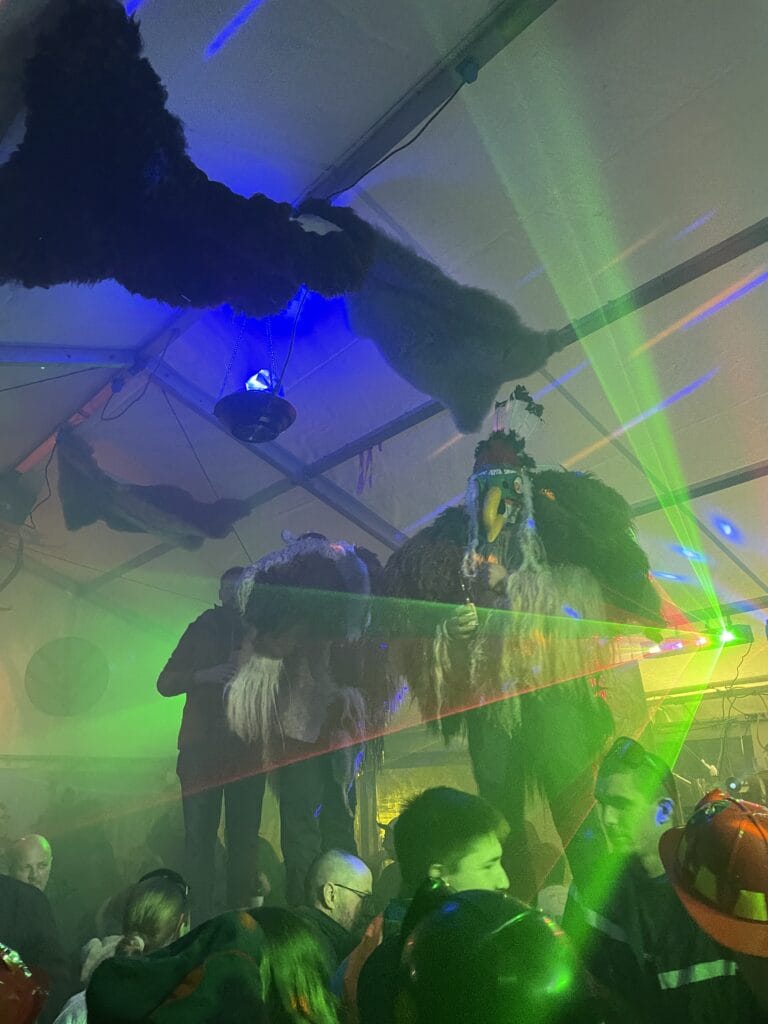
On the last Saturday before Mardi Gras, the Maries are out and about! Watch out for their sometimes acerbic comments (often in dialect) 😉
Sunday Gras: As soon as dawn breaks, the festivities begin with a stuffing party in the Parc de la Dent-Blanche. Open to the public, this is a not-to-be-missed event! We love watching these youngsters add straw again and again. The atmosphere is warm and friendly!
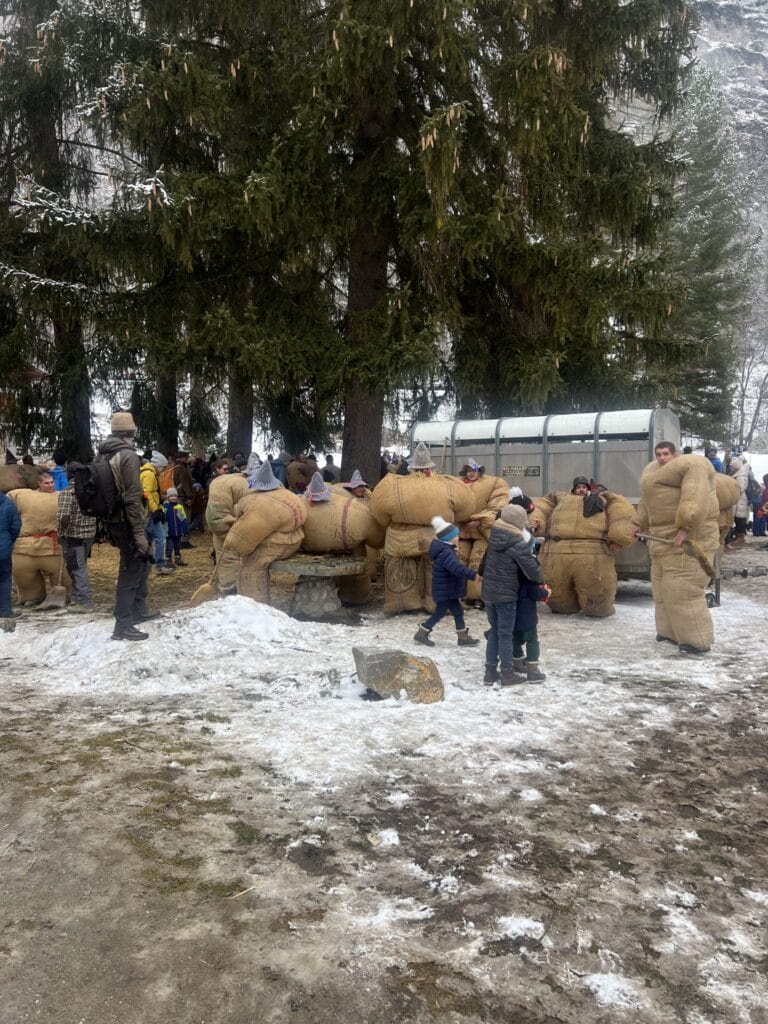
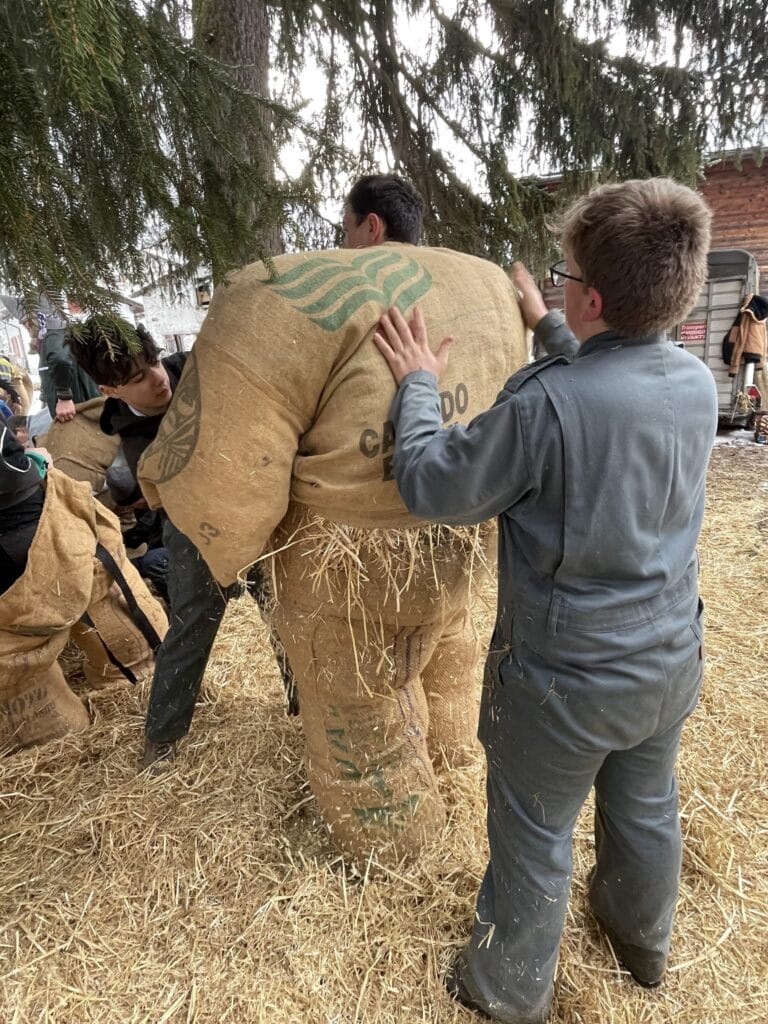
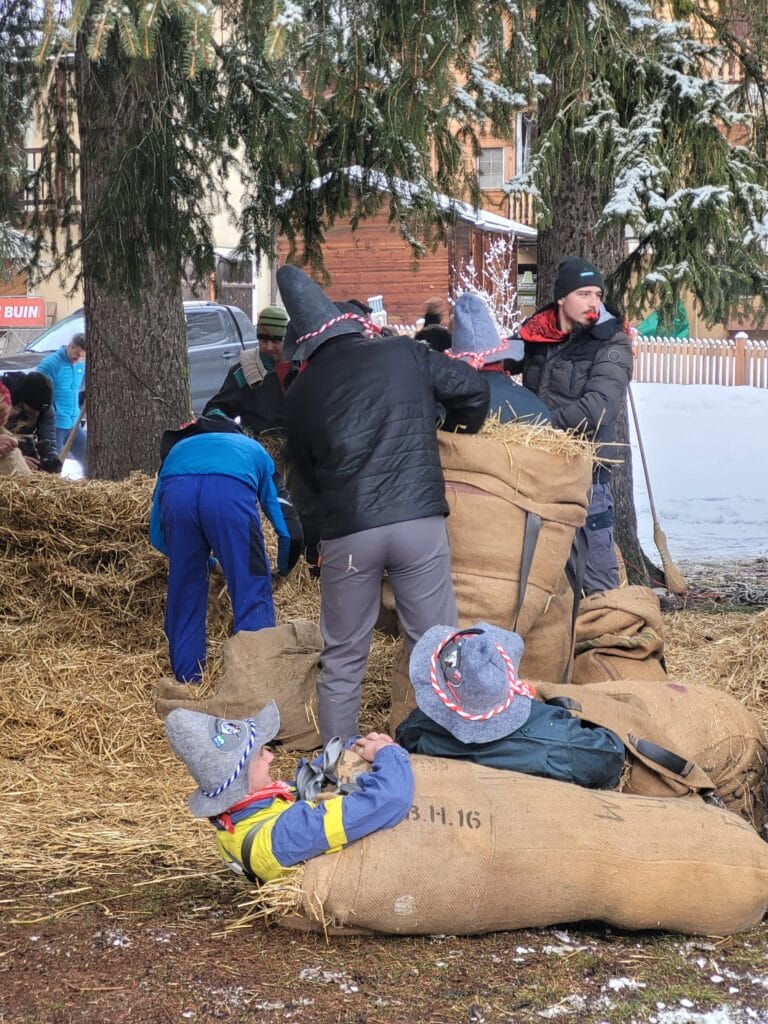
At 10:30 a.m. it’s time for mass in the Evolène church. As soon as mass ends, it’s time for the Déferlante des Peluches et des Empaillés in the streets of Evolène. A carnival highlight where young and old gather to watch these traditional characters wander through the streets.
From midday onwards, you can eat the traditional wild boar on the spit and enjoy the various musical entertainments. The festivities continue until late into the night in the village bars.
Lundi Gras: Arrest and Pleading of the Poutratze
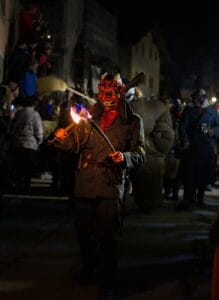
La Poutratze is a “empaillé” like no other, the winter man of the Evolène carnival, who has wandered off. The village children set out to find him, and he is then escorted by “soldiers” to the church square, where he is judged. In the form of a short play, this moment is a lot of fun to watch!
Mardi Gras: Judgment and Killing of the Poutratze
After her arrest and judgment the day before, the Poutratze is this time led by a procession to the stake. Before the fire, the theater troupe reads out the verdict and the Testament of Gustave Chevignoule. It’s another hilarious moment, with peluche, villagers and visitors opening their eyes and ears wide. At the end of the reading of the Testament, the Poutratze is put to death on the stake, and a bonfire breaks out.
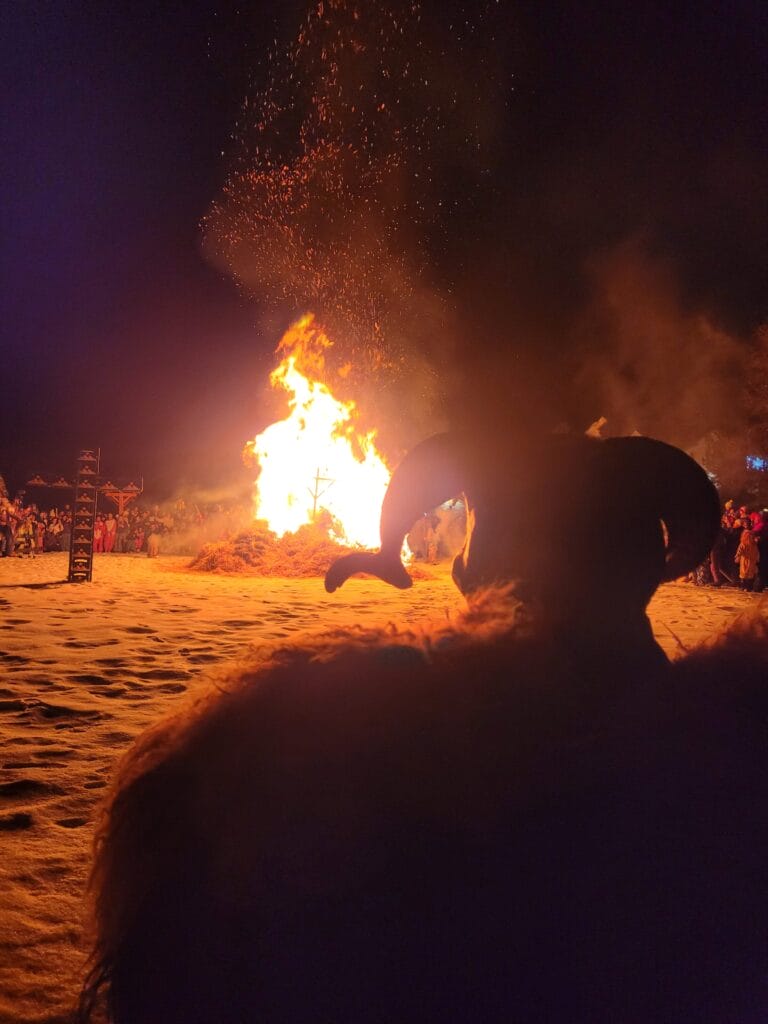
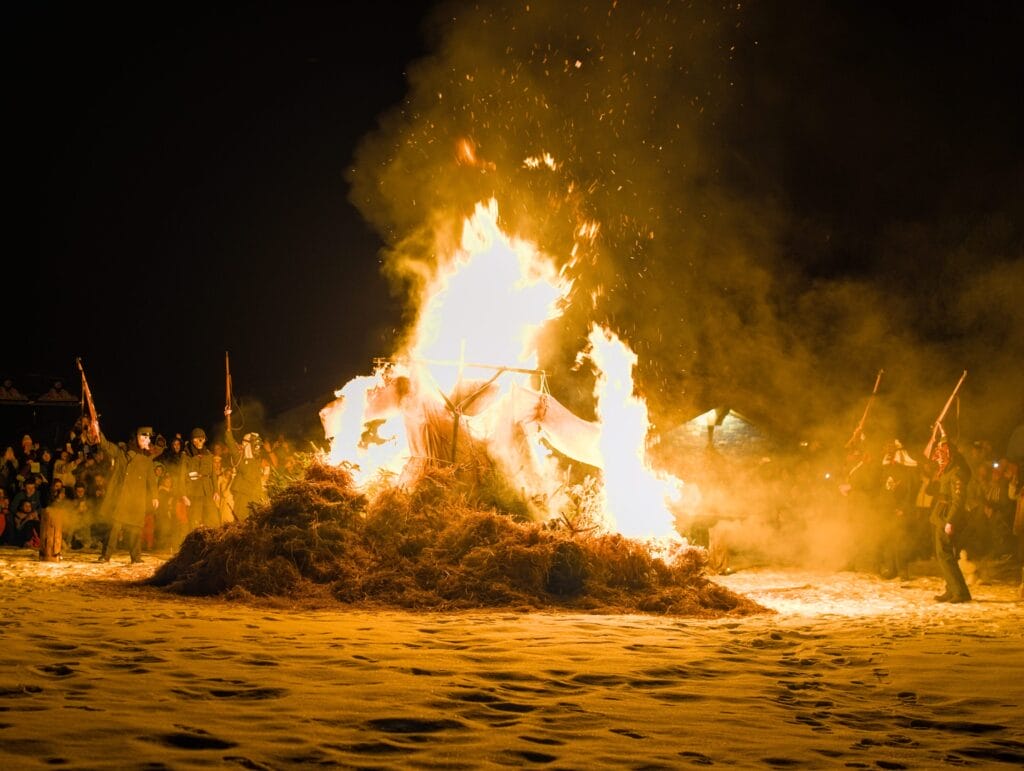
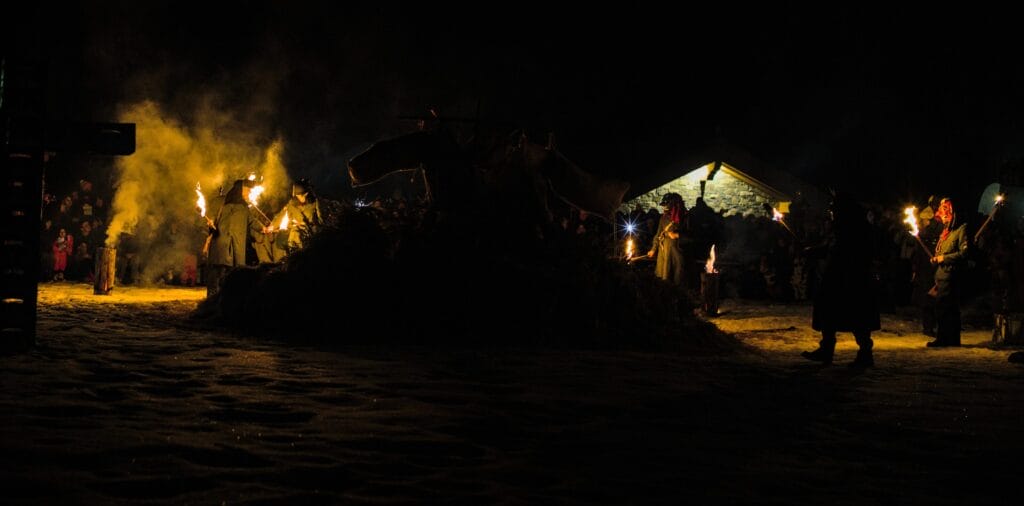
The evening continues in the streets of the village in the company of the peluches.
At midnight, all the peluches gather in front of the church and take off their masks! We discover who’s been hiding under those costumes all this time, and who’s been ruling the village for almost 2 months. An unforgettable finale to the Evolène carnival.
We have to wait almost 10 months before we can once again hear the bells announcing the imminent arrival of the peluches in the streets of Evolène.

Our friend Patricia ran a B&B for many years in the Val d’Hérens and knows the Valais and its traditions like the back of her hand. A few years ago, she launched a new activity: tourist concierge services in Valais. She offers her services to help you put together a 100% tailor-made stay, including as many of her good addresses as possible.
During Carnival, she also offers days out to discover the traditions of our beautiful region. On Carnival Sunday, for example, she offers to accompany you on the parade (she knows the best spots to set up and will enrich your day with many anecdotes and local stories). If you’d like to discover carnival in a different way, we highly recommend getting in touch with her! More info on her website Youpitrip.ch (website is in French only, but Patricia speaks English as well)

We also recommend you take a look at his latest book: 111 lieux en Valais à ne pas manquer. Published in 2024 by Emons, this book is a nugget for all lovers of the Valais. As the title might suggest, it is however only available in French. 😉
Patricia has made a point of highlighting hidden treasures as well as unusual and atypical places, all drawn from her explorations of the Valais.
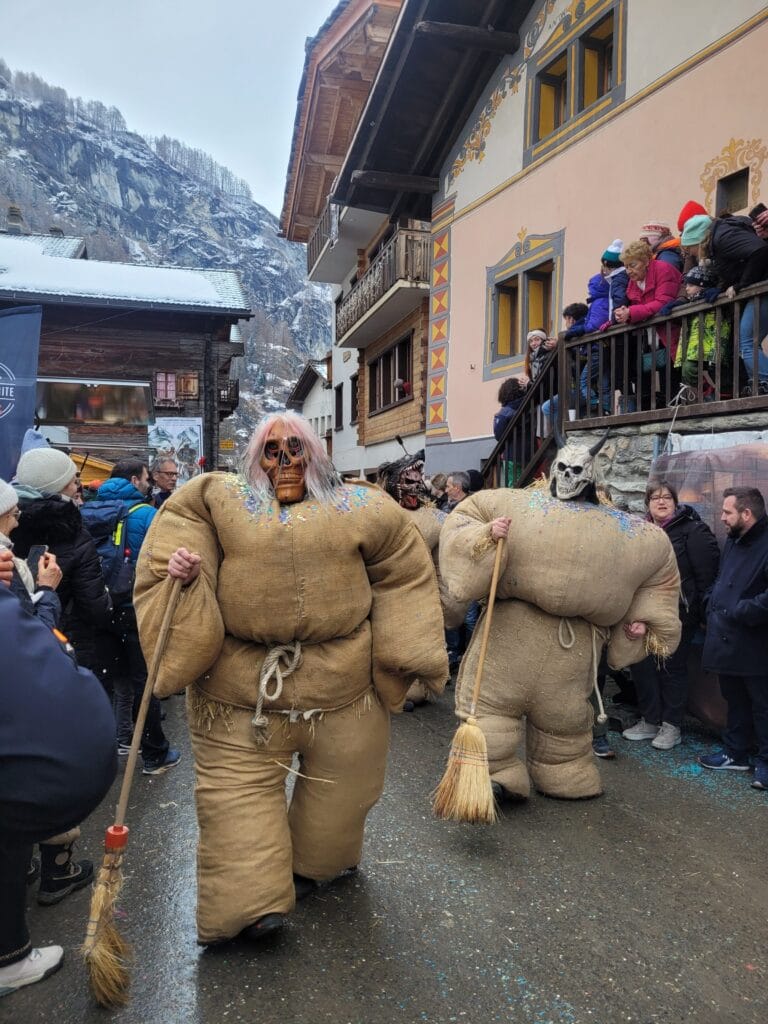
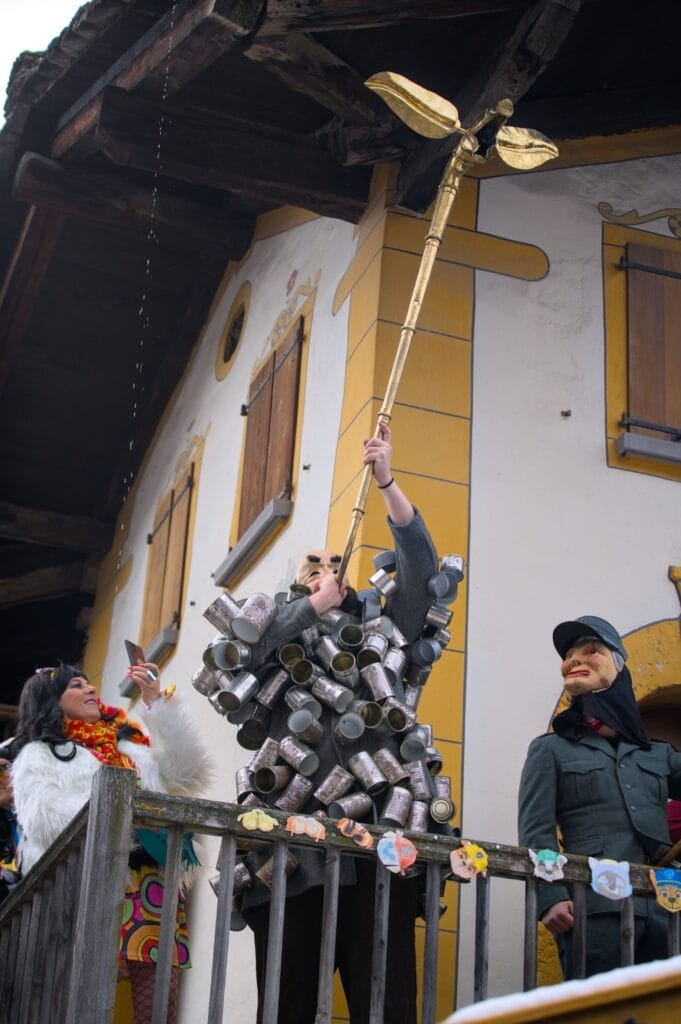
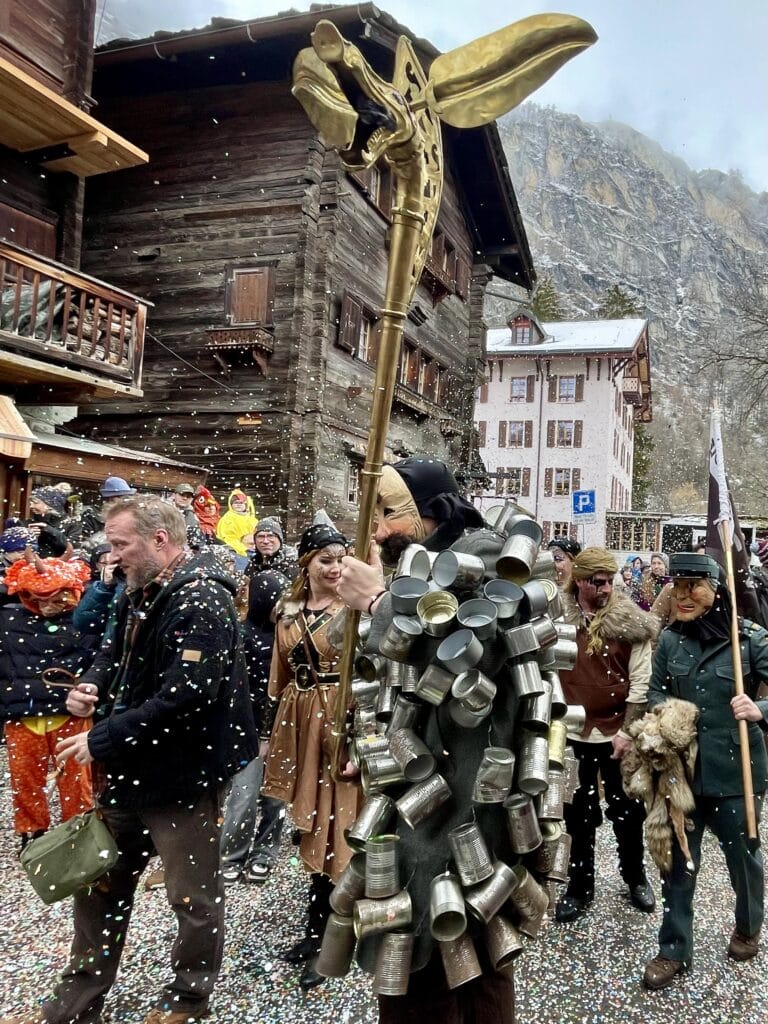
So that’s it for today, I hope you’ve enjoyed this article and found out a little more about this magnificent mountain tradition that brings our beautiful valley to life in winter. If you’re in the area, I urge you to come and discover this absolutely unique atmosphere with your own eyes. To conclude, I leave you with the quote that best sums up this festival:
The Evolène Carnival can’t be explained, it has to be experienced!
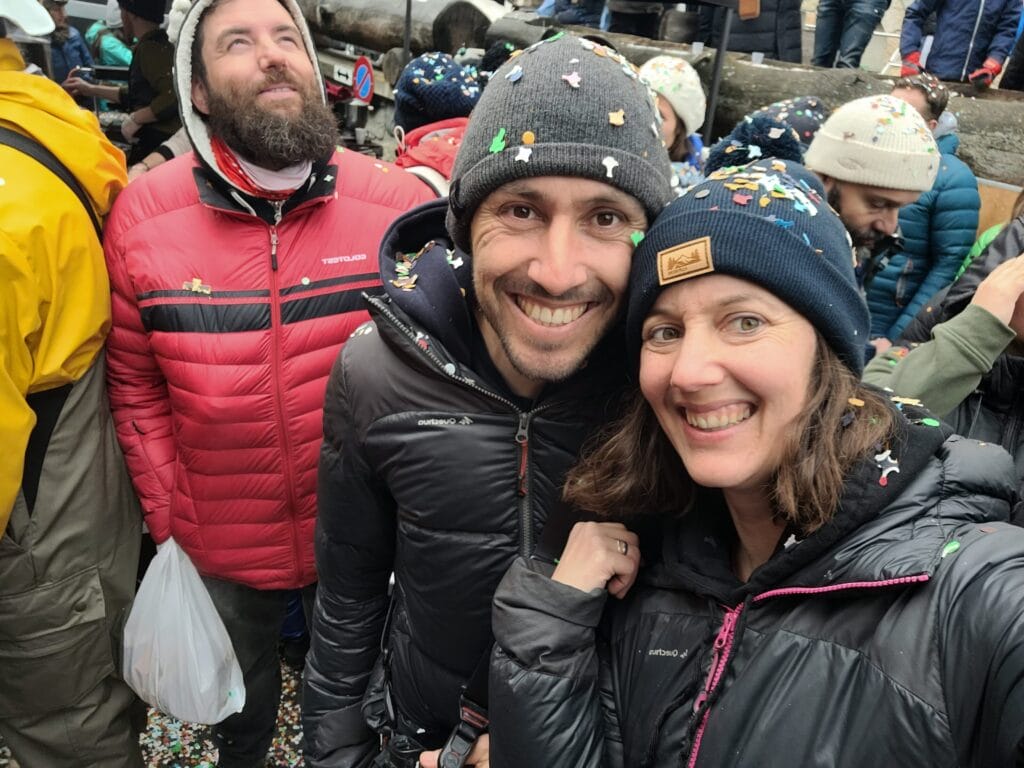
Pin it
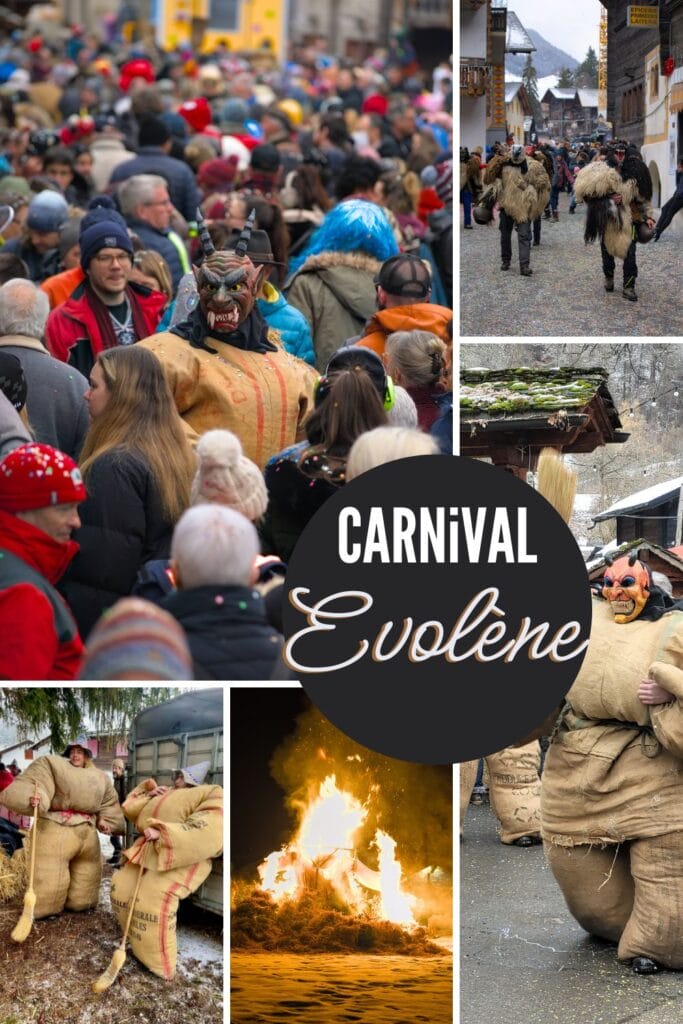
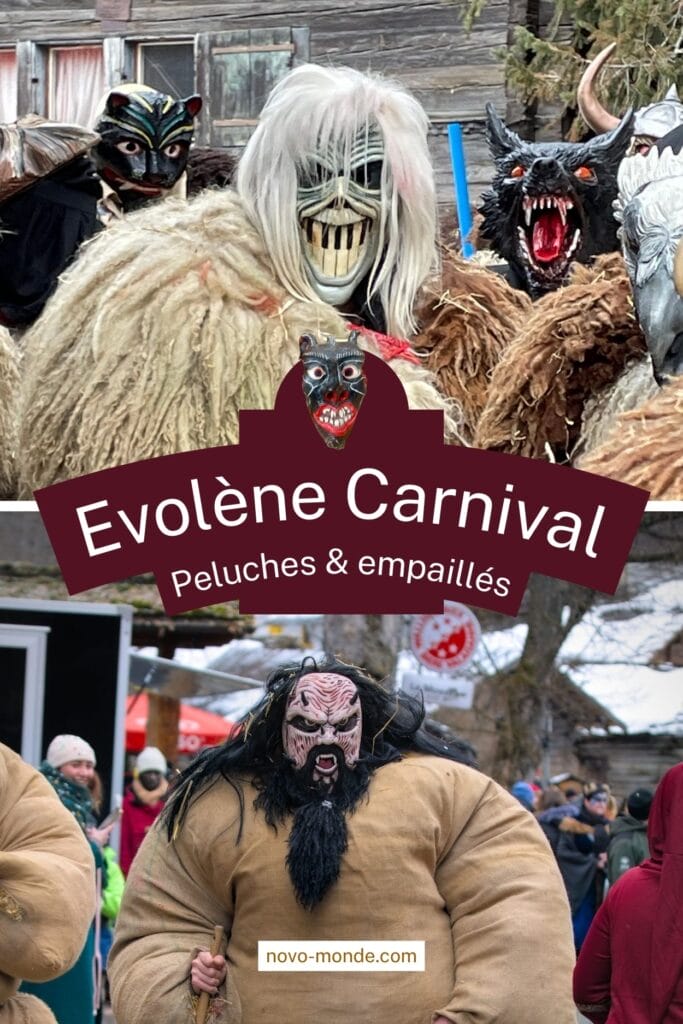
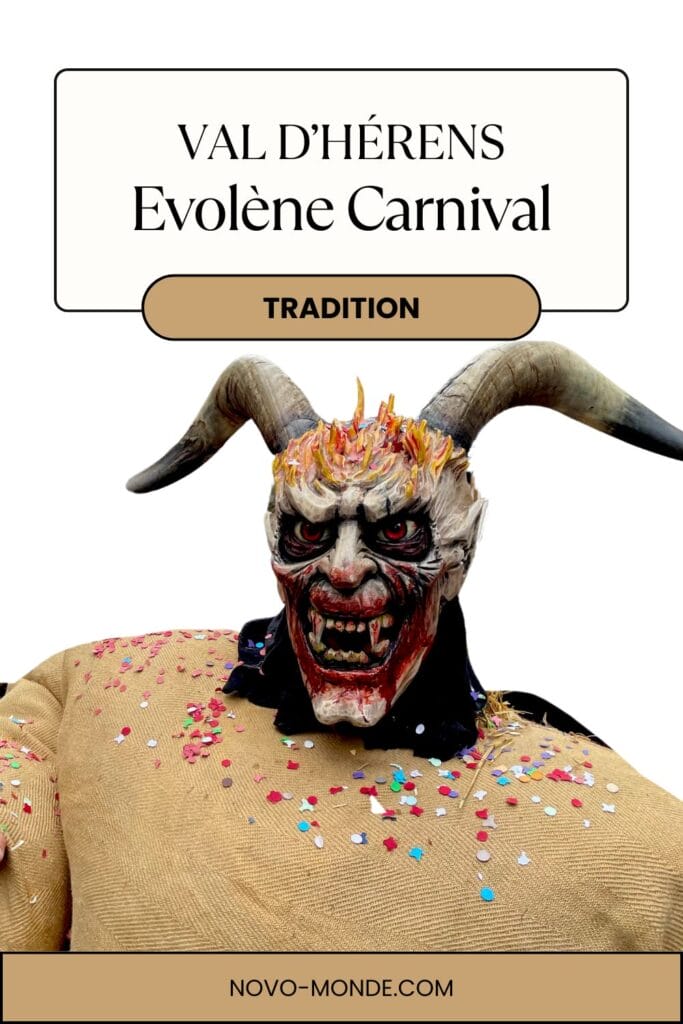
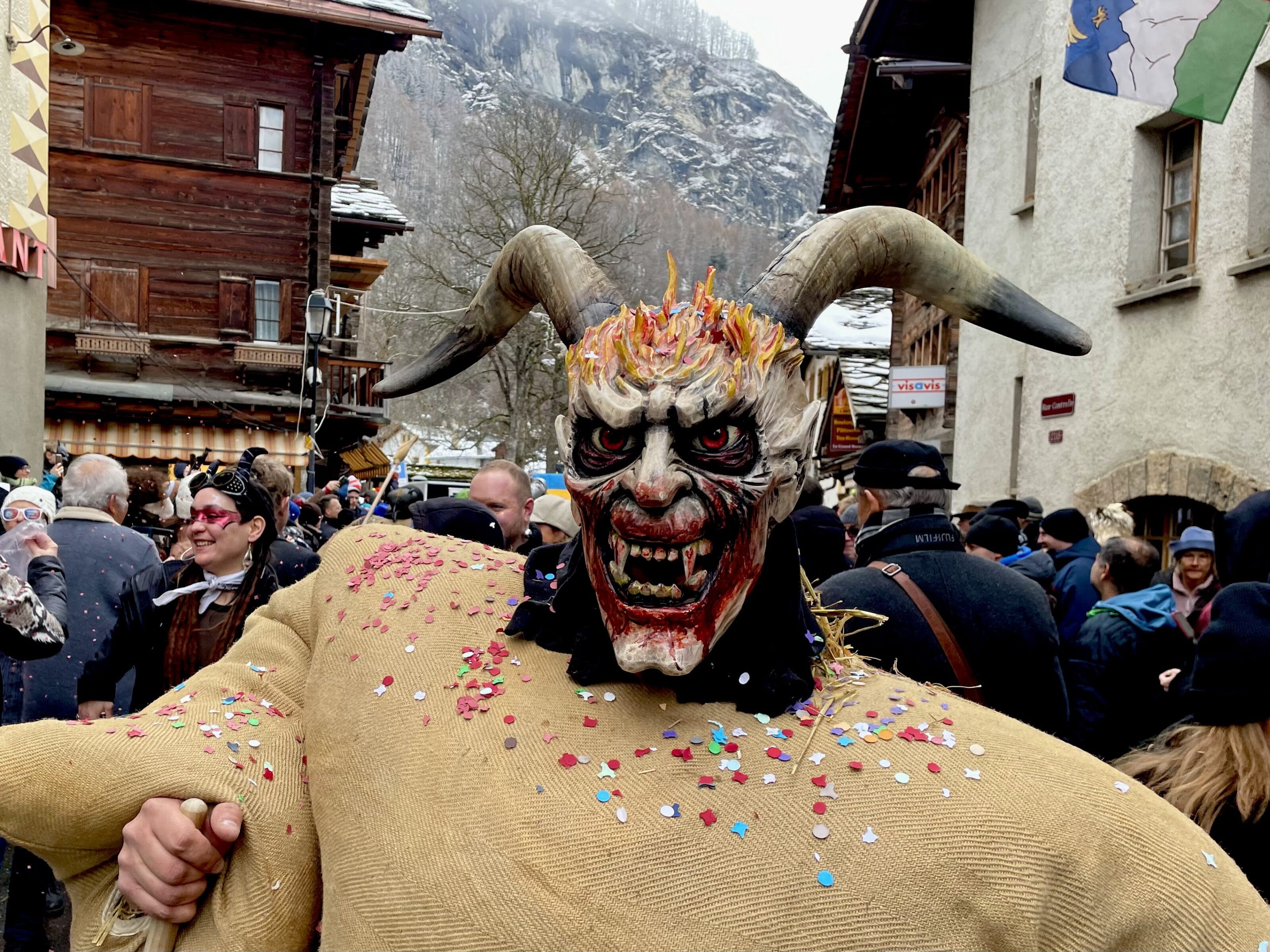


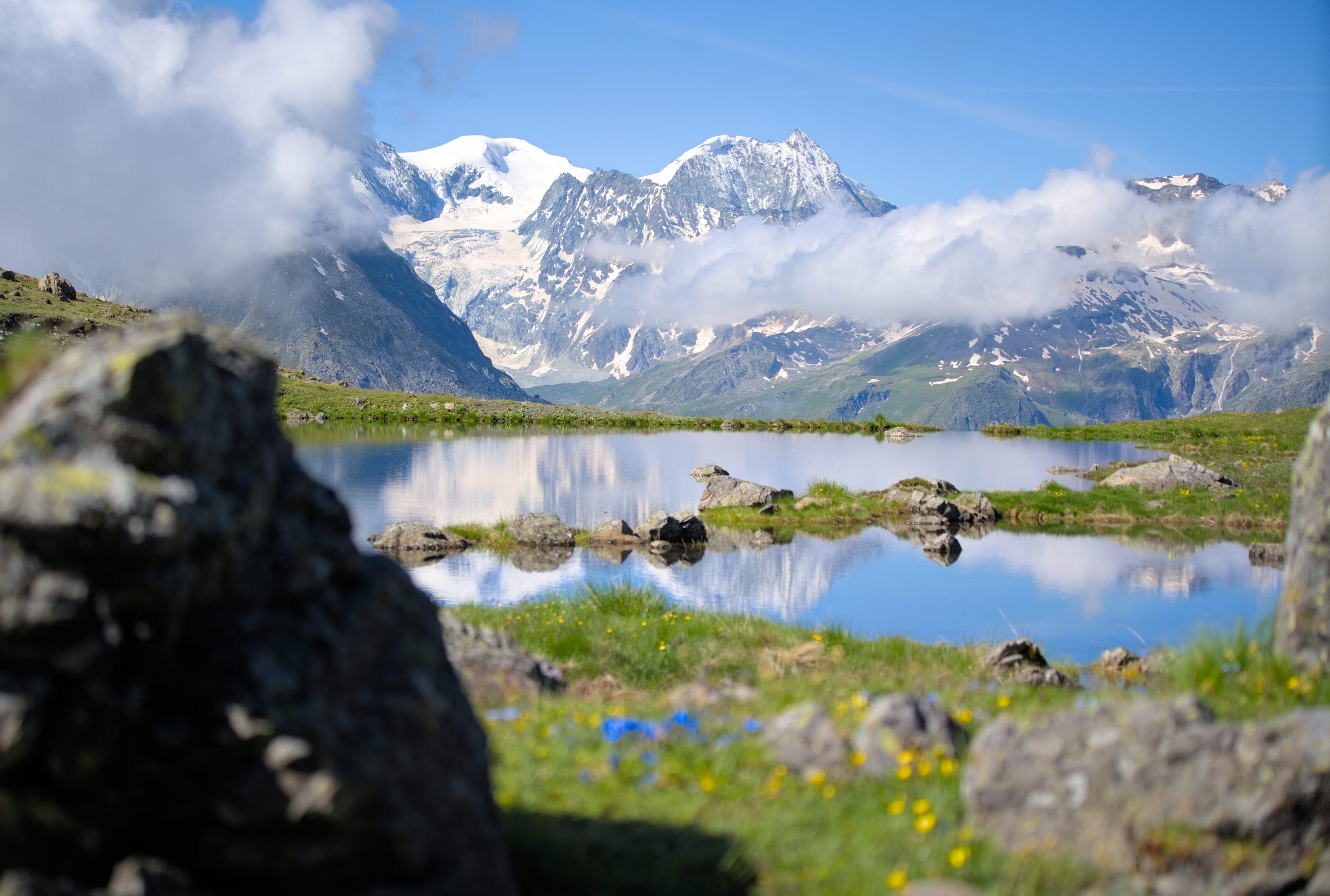
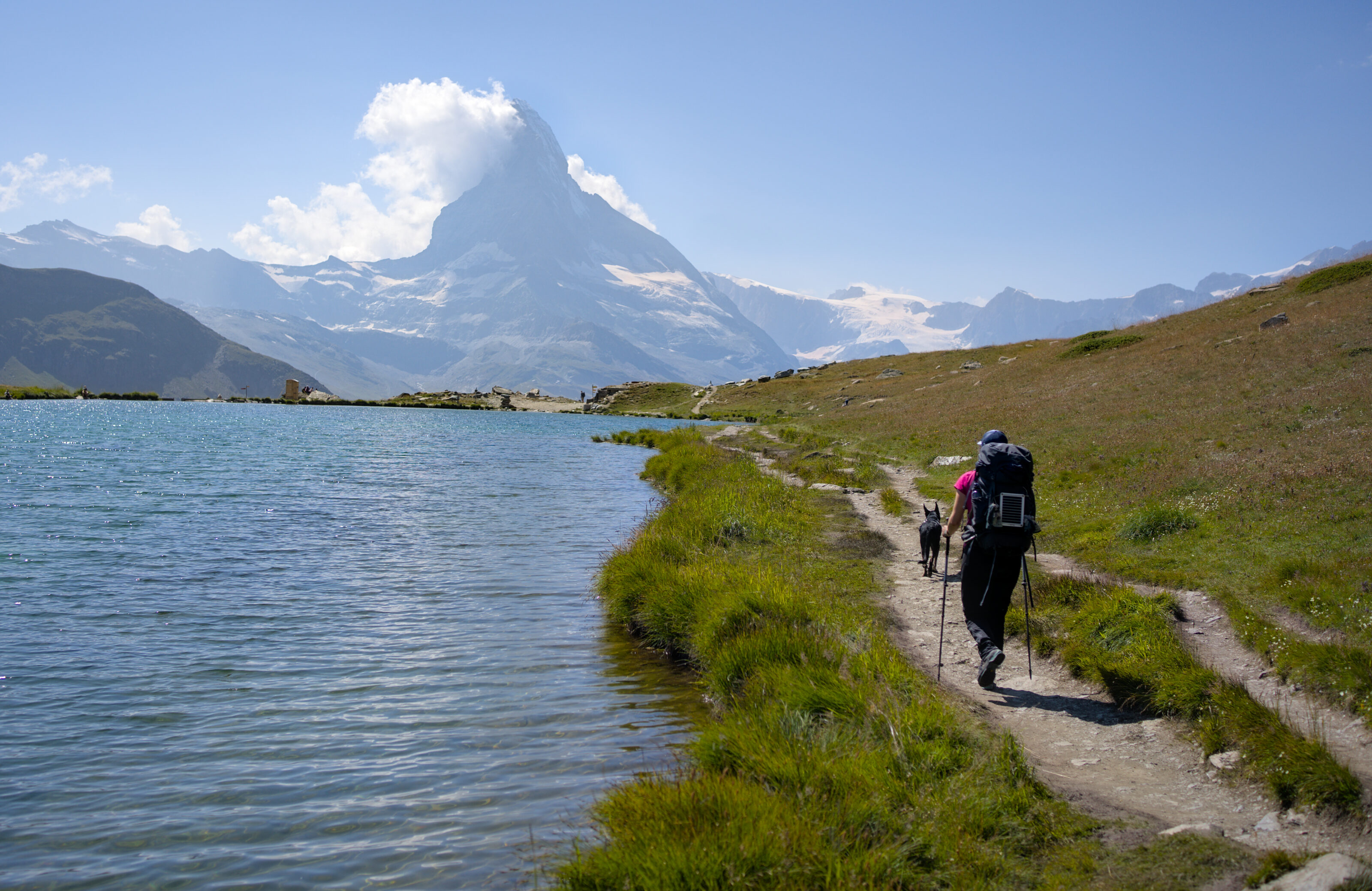

Join the discussion